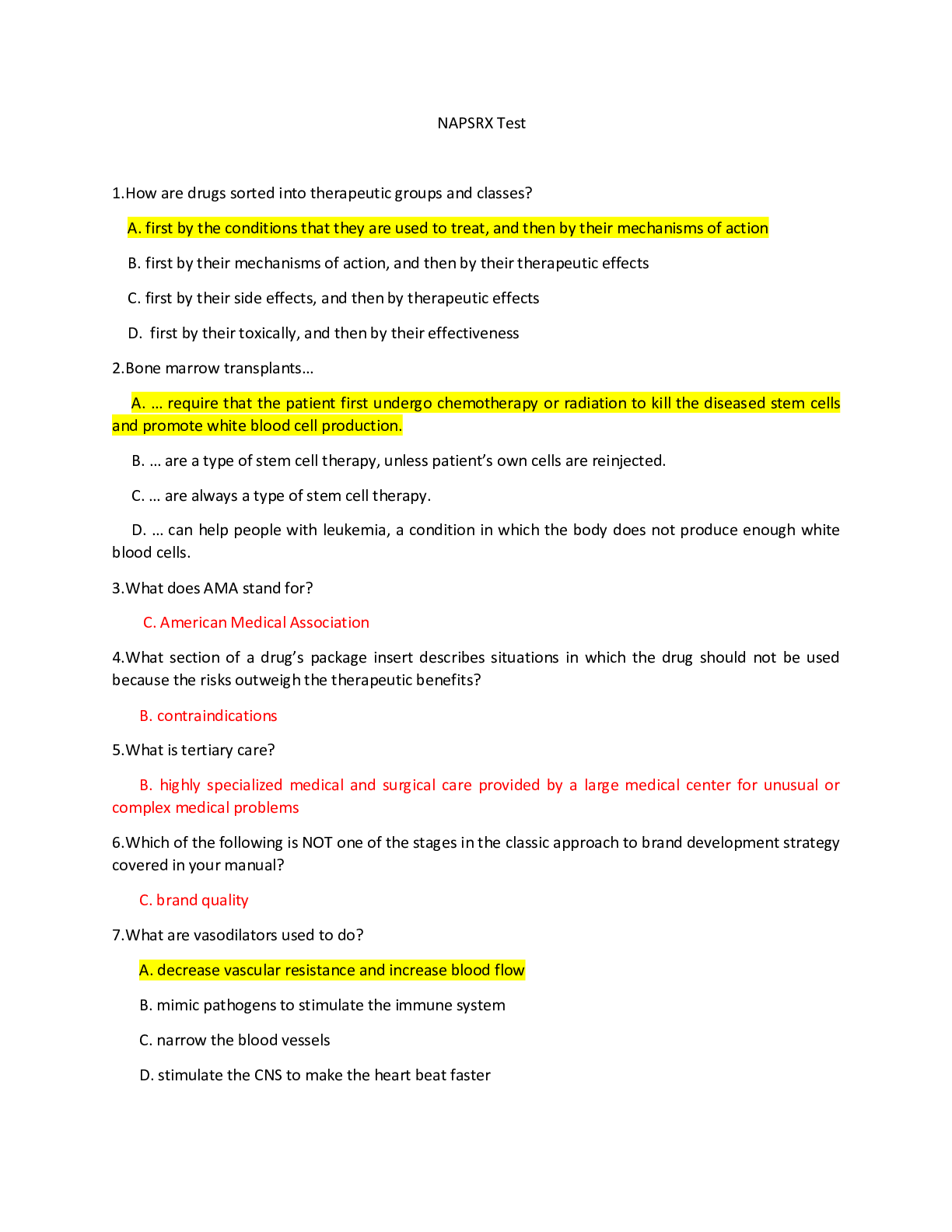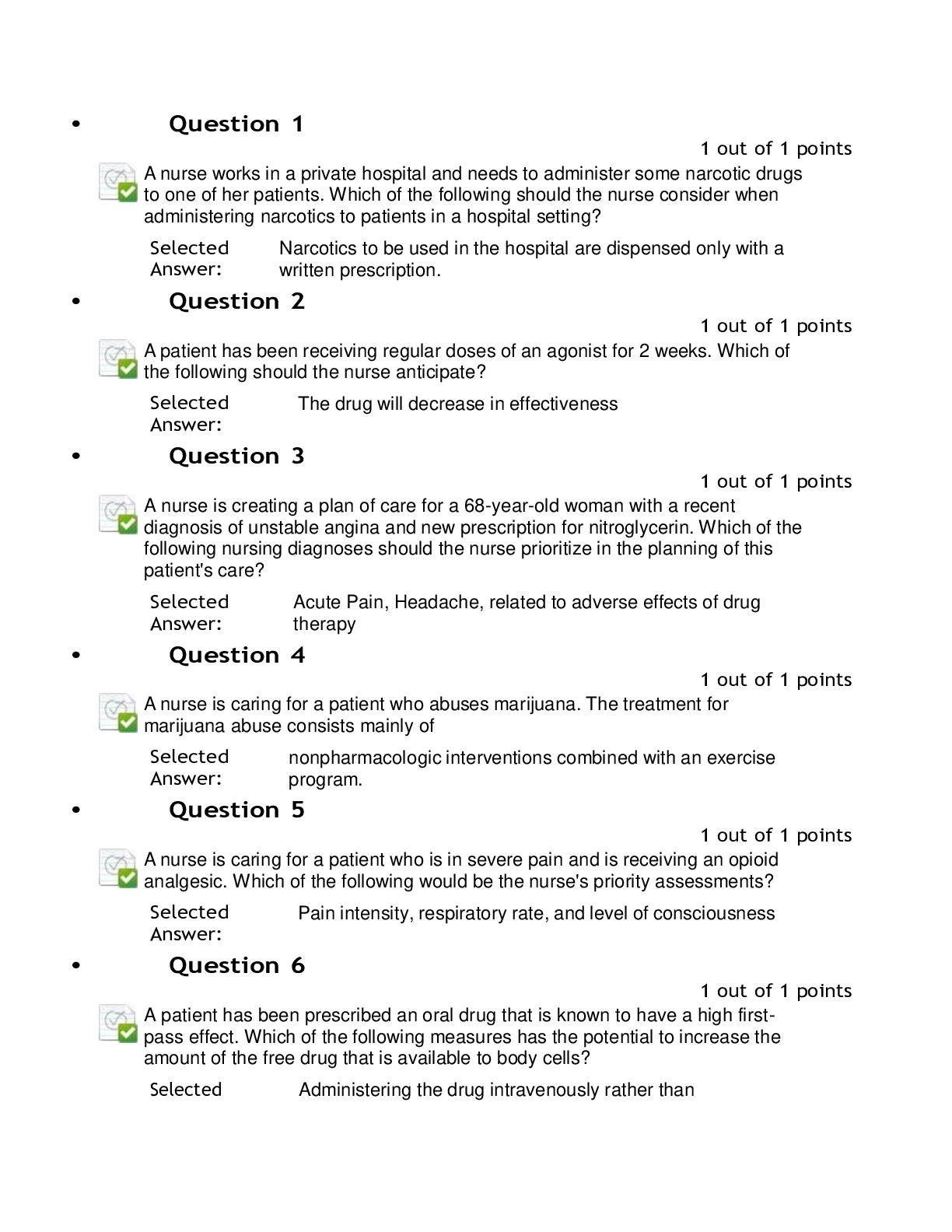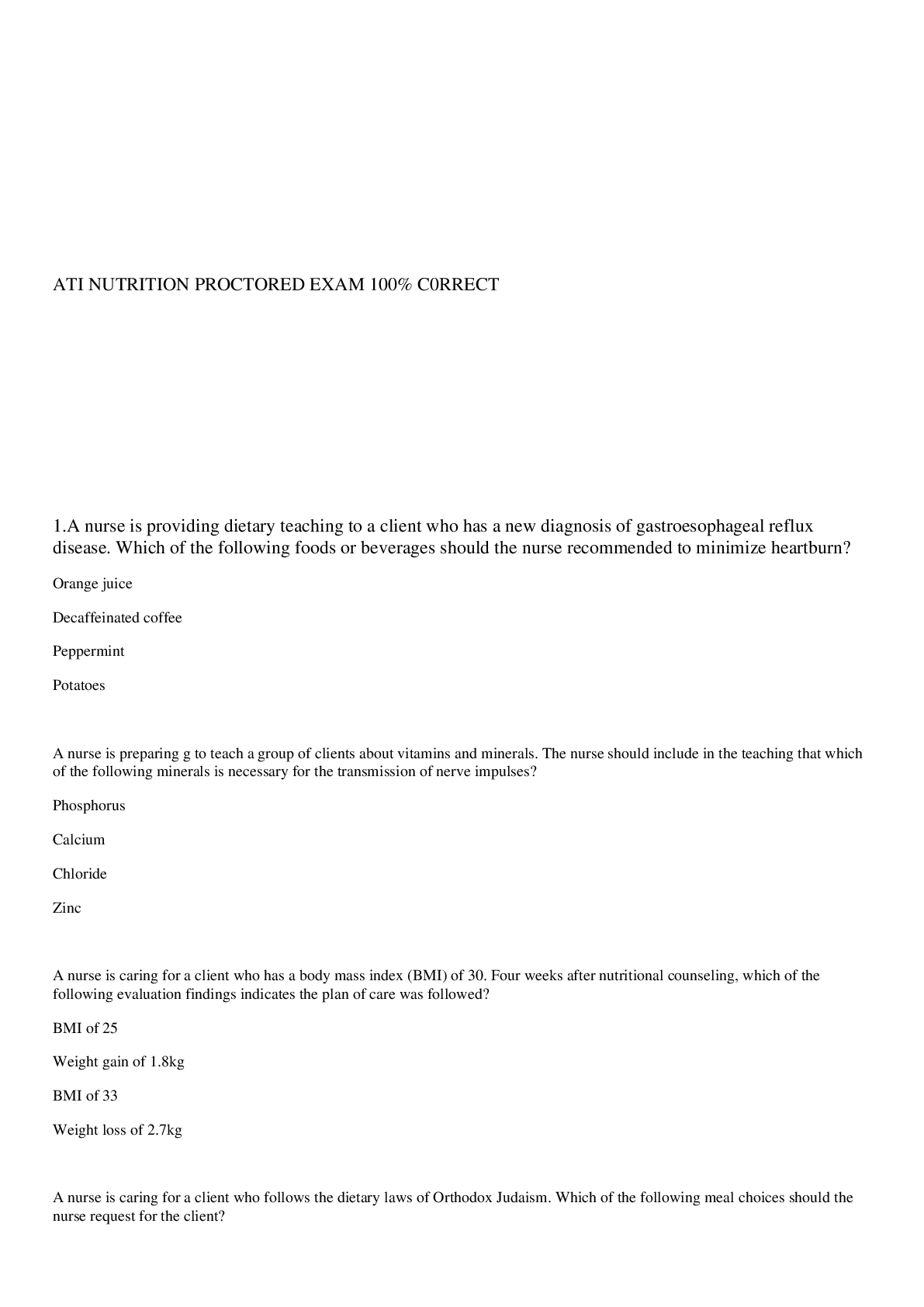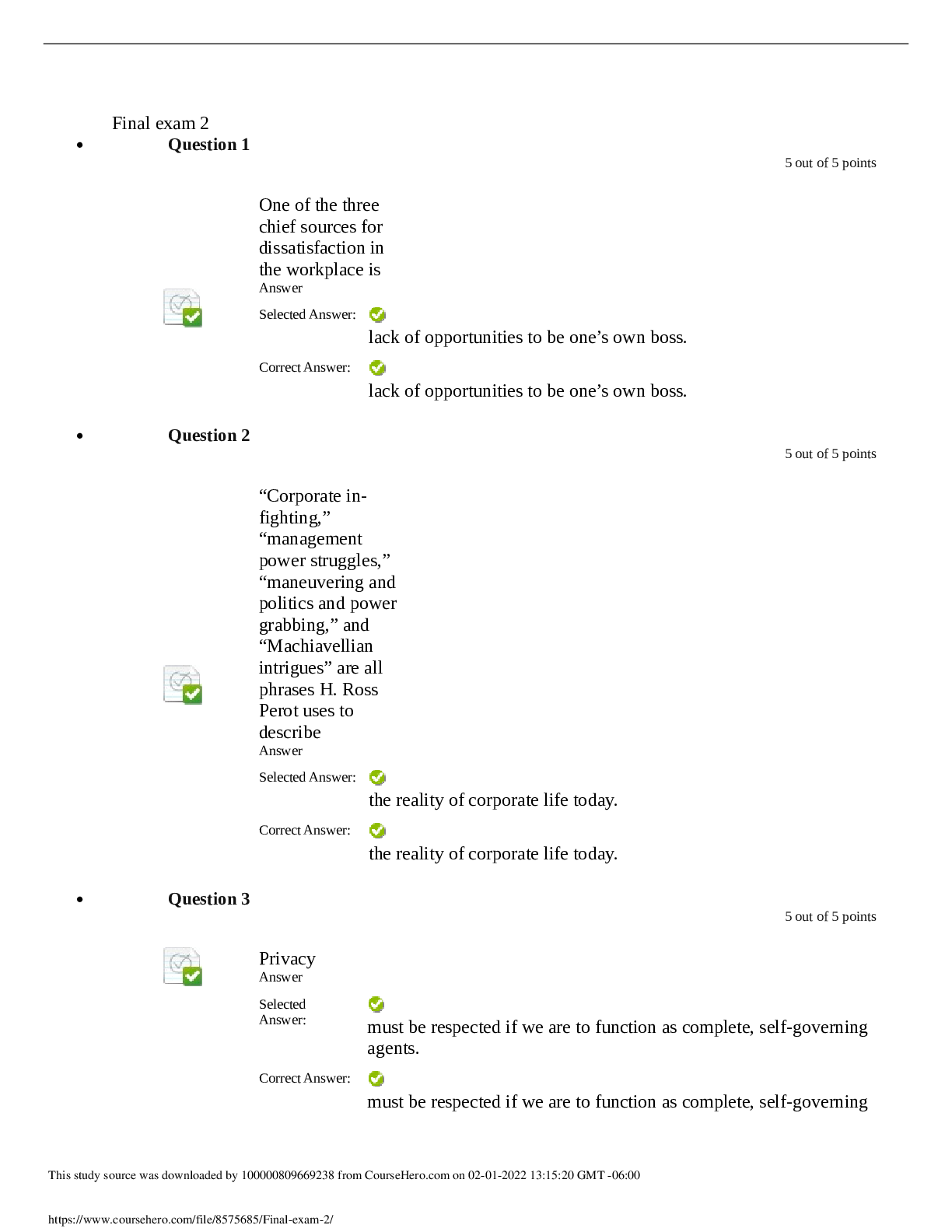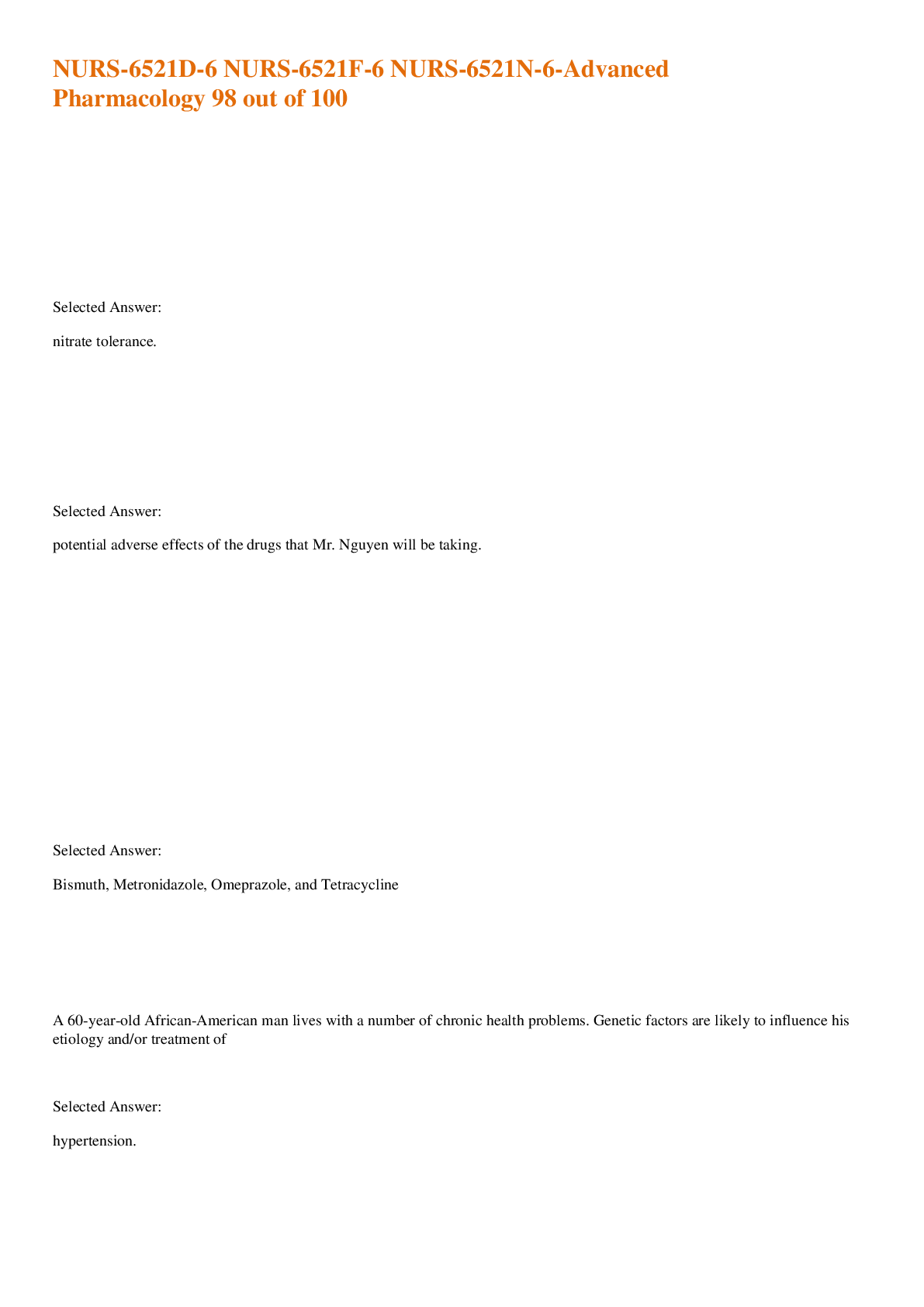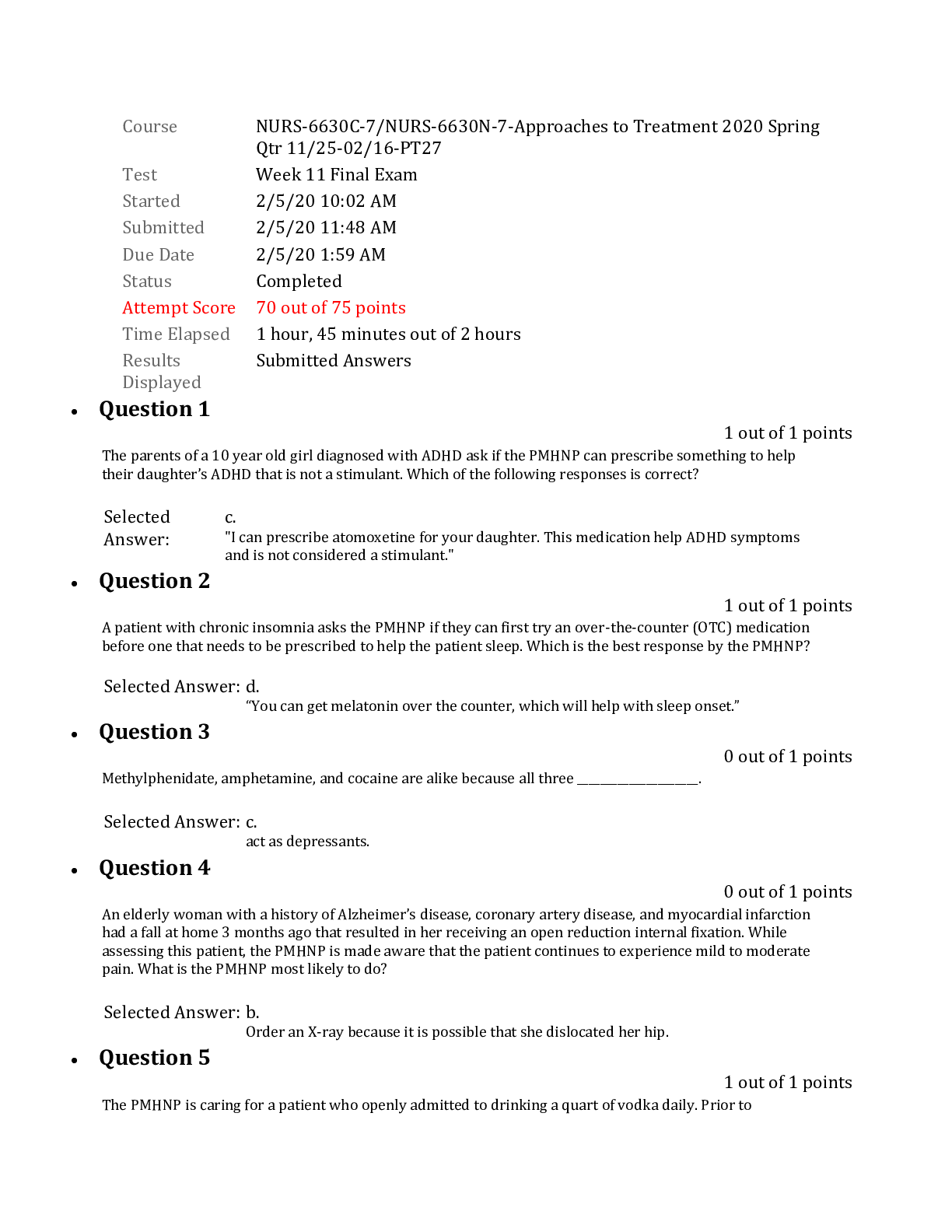*NURSING > EXAM > ATI Fundamentals. Questions and Answers. (GRADED & CORRECT ANSWERS HIGHLIGHTED) (All)
ATI Fundamentals. Questions and Answers. (GRADED & CORRECT ANSWERS HIGHLIGHTED)
Document Content and Description Below
ATI Fundamentals 1. 2. A nurse is caring for a client who is scheduled to have his alanine aminotransferase (ALT) level checked. The client asks the nurse to explain the laboratory test. Whic... h of the following is an appropriate response by the nurse? a. “This test will indicate if you are at risk for developing blood clots b. “This test will determine if your heart is performing properly” c. “This test will provide information about the function of your liver” d. “This test is used to check how your kidneys are working” Rationale: Leadership 7.0. ALT and AST measure you liver function. Creatinine and BUN measure your kidney function. 3. A nurse is caring for a client who has a prescription for morphine 5mg IM accidentally administers the whole 10 mg from the single-dose vial. Which of the following actions should the nurse take first? a. Notify the client’s provider. b. Report the incident to the pharmacy. c. Complete an incident report. d. Measure the client’s respiratory rate. Rationale: Morphine can cause respiratory depression if given too much. Also you should ALWAYS ASSESS the patient first when a med error is performed to make sure med error doesn’t put the client’s health in risk. 4. A nurse is preparing to administer diphenhydramine 20 mg orally to a 6-year-old child who has difficulty swallowing pills. Available is diphenhydramine 12.5 mg/5 mL oral syrup. Which of the following images shows the correct # of mL the nurse should administer? (Round the answer to the nearest whole number.) Click on the syringe that has 8 mL of med. 20 mg x (5mL/12.5mg) = 8 mL 5. A nurse is caring for a 6-year-old child who has a new prescription for cefoxitin 80 mg/kg/day administered intravenously every 6 hour. The child weighs 20 kg. How much cefoxitin should the nurse administer with each dose? (Round the answer to the nearest whole number. Use a leading zero if it applies. Do not use a trailing zero.) • So it says each dose for the final answer, but we are given 80 mg/kg/day. • 80 x 20 = 1600 / 4 (dose is given every 6 hours a day) = 400 mg 6. A nurse is preparing to administer IV fluids to a client. The nurse notes sparks when plugging in the IV pump. Which of the following actions should the nurse take first? a. Label the pump with a defective equipment sticker. b. Unplug the pump. c. Obtain a replacement pump. d. Notified the biomedical department to fix the pump. Rationale: Prioritization question. YOU WILL FIRST UNPLUG the IV pump to avoid causing a fire. 7. A nurse is caring for a client who has a surgical wound. Which of the following laboratory values places the client at risk for poor wound healing? Ch a. Serum albumin 3 g/dL b. Total lymphocyte count 2400 mm3 c. HCT 42% d. HGB 16g/dL Rationale: Albumin in low. Normal range is 3.5 to 5.5 g/dL. Low albumin places the client at risk for poor wound healing. The other lab values are within normal limits. 8. A nurse is preparing to check a client's blood pressure. Which of the following actions should the nurse take? Chapter 27 Vitals signs page 244 a. Apply the cuff above the clients antecubital fossa. b. Use a cuff with a width that is about 60% of the client's arm circumference.- width of the cuff should be 40 % of arm circumference c. How the clients sit with his arm resting above the level of his heart.- MUST BE AT HEART LEVEL d. Release the pressure on the client's arm 5 to 6 mm per second.- pressure release should not be more than 2 to 3 mm hg per second Rationale: ATI FUNDA says 40% of the arm circumference pg. 139. Release the pressure no faster than 2 to 3 mm Hg per second. Apply the BP cuff 2.5 cm (1 in) above the antecubital space with the brachial artery in line with the marking on the cuff. Apply the BP cuff 2.5 cm (1 in) above the antecubital space with the brachial artery in line with the marking on the cuff. 9. A nurse is preparing to perform nasal tracheal suctioning for a client. Which of the following is an appropriate action for the nurse to take? Chapter 53 Airway management page 563 a. Hold the suction catheter with the clean non-dominant hand. b. Apply suctioning for 20 to 30 seconds.- 10 -15 seconds is the maximum. c. Place the catheter in a location that is clean and dry for later use new line.- NEVER EVER REUSE THE SUCTION CATHETER . you throw it away after being used. d. Use surgical asepsis when performing the procedure. Rationale: ATI FUNDA. PG. 316 Use surgical asepsis for all types of suctioning. No longer than 10-15 seconds to avoid hypoxemia 10. A nurse is documenting client care. Which of the following abbreviations should the nurse use?ati book was not thorough so i had to go on different sites for charts - not confident with this, please double check. a. “SS” for sliding scale b. “BRP” for bathroom privileges c. “OJ” for orange juice- do not d. “SQ” for subcutaneous- do not 11. MISSING 12. A nurse is collecting A blood pressure reading from a client who is sitting in a chair period the nurse determines that the clients BP is 158/96 mmhg. which of the following actions should the nurse take? a. Ensure that the width of the BP cuff is 50% of the client’s upper arm circumference. It says 40% b. Reposition the client Supine and recheck her BP. BP. → ORTHOSTATIC HYPOTENSION c. Recheck the clients BP and her other arm for comparison. d. Request that another nurse check the the clients BP in 30 minutes. → 15 minutes 13. A nurse is caring for a client who has left lower atelectasis. in which of the following positions should the nurse place the client for postural drainage? Chapter 53 Airway Management page 562 a. Supine and low-Fowler's position b. Right lateral in Trendelenburg position c. Side lying with the right side of the chest elevated d. Prone with pillows under the extremities 14. A nurse is receiving the prescription for a client who is experiencing dysphagia following a stroke. Which of the following prescriptions should the nurse clarify? a. Dietitian consult b. Speech therapy referral c. Oral suction at the bedside d. Clear liquids Rationale: ATI MS. Pg. 83 food levels for dysphagia include pureed, mechanically altered, advanced/mechanically soft, and regular. Liquids must be THICK.. Clear liquids can cause aspiration 15. A nurse is administering a large volume enema to a client. Identify the sequence of steps the nurse should follow after preparation and lubricating the enema set.(ati funds video enema) 1. Administer the enema solution.(2) 2. Remove the enema tube from the clients rectum.(4) 3. Wrap the end of the enema tube with a disposable tissue.(5) 4. Insert the enema tube into the client's rectum.(1) 5. Clamp the enema tube.(3) 16. A nurse is inserting an NG tube for a client who requires gastric decompression. Which of the following actions should the nurse take to verify proper placement of the tube? a. Place the end of the NG tube in water to observe for bubbling. b. Auscultate 2.5 cm (1 in) above the umbilicus while injecting 15 mL of sterile water. AIR NOT WATER OR BY ASPIRATING GASTRIC FOR PH. c. Assess the client's gag reflex. d. Measure the pH of the gastric aspirate. 17. A nurse is teaching a group of newly licensed nurses about the Braden Scale. Which of the following responses by the newly licensed nurse indicates an understanding of the teaching? a. “The client’s age is part of the measurement.” - rationale is same as b. b. “The scale measures six elements.” - The six elements are 1. Sensory Perception, 2. Moisture, 4. activity, 5. mobility ,6. nutrition , 7. friction and shear. c. “The higher the score, the higher the pressure ulcer risk.”- the higher the score the better chance the patient has of NOT getting an ulcer . score of 12 or less is high risk. Anything above 18 is healthy. d. “Each element has a range from 1 to 5 points.”- each elements is scored from 1-4 actually . 18. A nurse is caring from a client who has a tracheostomy. Which of the following actions should the nurse take? a. Clean the skin around the stoma with normal saline. b. Secure the tracheostomy ties with one finger to fit snugly underneath. → 2 snug fingers widths under neck strap c. Soak the outer cannula in warm tap water. STERILE NS d. Use a cotton tip applicator to clean the inside in the inner cannula. <to clean OUTER cannula surfaces, cllity- approved solution>ean the inside with the faci Rationale: according to POTTER, funda pg. 866 using NS-saturated cotton-tipped sterile swabs and 4x4 gauze, clean exposed outer cannula surfaces and soma under faceplate, extending 5-10cm (2-4in) in all directions from stoma. 19. A nurse is documenting in a client’s medical record . Which of the following entries should the nurse record? a. “Incision without redness or drainage.” b. “Drink adequate amounts of fluid with meals.” WHATS THE AMOUNT c. “Oral temperature slightly elevated at 0800.” WHATS THE TEMP <Any action & change to the client’s condition should be recorded> 20. A staff nurse is teaching a newly hired nurse about alternatives to the use of restraints on clients who are confused. Which of the following instructions should the nurse include? a. “Use full-length side rails on the client’s bed.” b. “Check on the client frequently while he is in the restroom.” c. “Encourage physical activity throughout the day to expand energy.”(only one makes sense couldn't find in ati book ) d. “Remove clocks from the client’s room.” 21. A nurse in an emergency department is assessing a clients who reports RIGHT lower quadrant pain, nausea and vomiting for the past 48 hr. Which of the following actions should the nurse take first . a. Auscultate bowel sounds. ADPIE first but i will research more into this b. Administer an antiemetic. c. Offer a pain med. d. Palpate the abdomen. Possible appendicitis “nausea/vomiting” with RLQ pain. (IAPP) INSPECTION. AUSCULTATE. PERCUSS. PALPATE- FOR BOWEL 22. A nurse is assessing a client’s extraocular eye movements. Which of the following should the nurse take ? a. Instruct the clients to follow a finger through the six cardinal fields of gaze. (Cardinal fields of gaze test for cranial nerves 3, 4, and 6 which are for eye movement) b. Hold a finger 46 cm (18 in) in front of the clients eyes. c. Ask the clients to cover her right eye during assessment of her left eye. d. Position the clients 6.1 m (20 feet) away from the Snellen chart. (This is for cranial nerve 2) 23. A nurse is providing a teaching to a client who had a new medication prescription . Which of the following manifestations of a mild allergic reaction should the nurse include a. Urticaria b. Ptosis c. Nausea d. Hematuria 24. A provider prescribes cold application for a client who reports ankle joint stiffness. Which of the following assessments findings should the nurse identify as a contraindication to the application of cold? a. Cap refill 4 seconds -ITS CONTRAINDICATED TO USE APPLICATION OF COLD b. 7.5 cm (3 in) diameter bruise on the ankle IT HELPS ON BRUISE c. Warts on the affected ankle d. 2+ pitting edema -HELPS REDUCE INFLAMMATION (EDEMA) 25. A nurse is caring for a client who has TB. Which of the following precautions should the nurse plan to implement when working with the client? Chapter 11 fundamentals 9.0 infection control page 52 a. Airborne - measle , varicella, pulmonary or laryngeal tuberculosis b. Droplet-streptococcal pharyngitis or pneumonia, Haemophilus influenzae type B, scarlet fever, rubella, pertussis, mumps, mycoplasma pneumonia, meningococcal pneumonia and sepsis, pneumonic plague). C.Protective- d..Contact- 26. A nurse is performing a dressing change on a client and observes granulation tissue. Which of the following findings should the nurse document? Chapter 55 Pressure ulcers, wounds and wound management fundamentals pdf page 330 a. Stringy, white tissue- same as slough. Means that it is sepatated from the body. b. Translucent, red tissue- red means healthy and its healing c. Soft, yellow tissue= means presence of slough and drainage. d. Thick, black tissue- black is necrotic = escahr is present and needs removal 27. A nurse is screening several clients at a neighborhood health fair. Which of the following assessments findings is the priority for referral for further care? a. Blood glucose 45 mg/dL LOW/HYPOGLYCEMIA MAY LEAD TO SHOCK b. Blood pressure 148/92 mm Hg STAGE 1 HYPERTENSION c. Body mass index 28 kg/m2 OVERWEIGHT d. Heart rate 105/min 28. A nurse is planning care for a client who has a new prescription for parenteral nutrition (PN) in 20% dextrose and fat emulsions. Which of the following is an appropriate action to include in the plan of care? a. Obtain a random blood glucose daily. b. Change the PN infusion bag every 48 hr. CHANGE Q24HR c. Prepare the client for a central venous line. d. Administer the PN and fat emulsion separately. ATI FUNDA PG. 298 Administer separate IV line below the filter using a Y-connector or as a admixture to PN solution (3-in-1 admixture consisting dextrose, AA, and Lipids 29. A nurse is providing teaching about health promotion guidelines to a group of young adult male clients. Which of the following guidelines should the nurse include? a. “Obtain a tetanus booster every 5 years.” b. “Obtain a herpes zoster immunization by age 50.” c. “Have a dental examination every 6 months.”(funds ati pg 201 says they need dental cause they are prone to infection) d. “Have a testicular examination every 2 years.” 30. A home health nurse is teaching a new caregiver how to care for a client who has had a tracheostomy for 1 year. Which of the following instructions should the nurse include? a. “Use tracheostomy covers when going outdoors.” Google b. “Maintain sterile technique when performing tracheostomy care.” c. “Remove the outer cannula for routine cleaning.” d. “Clean around the stoma with povidone-iodine.” NS 31. A nurse in the emergency department is measuring a client’s oral temperature using an electronic thermometer. Which of the following actions should the nurse take? Chapter 27 Vital sigsn p.133 a. Provide oral hygiene prior to measuring the client’s temperature. b. Ask the client if he has smoked within the past 30 min c. Attach the red tip probe to the thermometer unit. d. Place the tip of the probe along the client’s buccal mucosa.- must be unde the tongue in the posterior sublingual pocket lateral to the center of the lower jaw. 32. A nurse is caring for a client who had a stroke and requires assistance with morning ADLs. Which of the following interprofessional team members should the nurse consult? a. Registered dietician- helps with healthy food planning. b. Occupational therapist chapter 2 page 7 the interprofessional team. c. Speech-language pathologist- yes the question said stroke , but the question wants who will help him with every day ADLS. speech patho help them if they have a hard time swallowing. d. Physical therapist- is used of the patients cannot even move his muscles. 33. MISSING 34. A nurse overhears a colleague informing a client that he will administer her medication by injection if she refuses to swallow her pills. The nurse should recognize that the colleague is committing which of the following torts? a.) Defamation- you embarass someone by making fun of them. b.) Malpractice- you did something by accident c.) Assault- verbal threatening d.) Battery- actually causing physical harm or trauma. 35. A nurse is caring for clients who is prescribed a buccal medication. Which of the following client statements indicates that the client understands how to take this medication? a. “I will first dissolve the tablet in water.” b. “I will insert the tablet between my cheek and teeth.” c. “I will place the tablet under my tongue.”- this is sublingual d. “I will chew the tablet.”- this is oral 36. A nurse is a admitting a client who is malnourished. The client states my wedding ring is loose and I'm worried I will lose it if it falls off. Which of the following is an appropriate response by the nurse? a. “I can pin it to your hospital gown so you won't lose it.” b. “I will place it in your drawer so it won't get lost.” c. “I will hold onto it until a family member can take it home.” d. “I can put it in a locked storage unit for you.” 37. A nurse is changing a client's colostomy pouch and notices peristomal skin irritation. Which of the following actions should the nurse take? a. Change the pouch once every 24 hour. b. Apply the pouch while the skin Barrier is still damp.(no ) c. Rub the peristomal skin dry after cleaning. (No it will irritate skin more ) d. Ensure the pouch is 0.32 cm (1/8 in) larger than the stoma. rationale : ATI FUNDA PG 241 38. A nurse is preparing change of shift report after the night shift using one sbar communication tool. which of the following data should the nurse include when reporting background information? a. “Blood pressure 160/92 mm Hg”- part of ASSESSMENT b. “Start first dose of penicillin at 1200”- c. “Pain rating of 5 on a scale from 0 to 10” d. “Code status: do-not-resuscitate” 39. A nurse is caring for a client who has extracellular fluid volume deficit. Which of the following findings should the nurse expect? Chapter 57 fluid volume imbalances page 343. a. Postural hypotension b. Distended neck veins c. Dependent edema d. Bradycardia - would be TACHY since SNS system kicks in when detects low blood volume TACHYCARDIA is for fluid overload. 40. A nurse is teaching a client how to self-administer daily low-dose heparin injections. Which of the following factors is most likely increase the client’s motivation to learn? a. The nurse empathy about the client having to self-inject b. The client's belief that his needs will be met through education c. The client seeking family approval by agreeing to a teaching plan d. The nurse explaining the need for education to the client 41. A nurse is conducting a Weber test on a client. Which of the following is an appropriate action for the nurse to take? a. Deliver a series of high-pitched sounds at random intervals. b. Place an activated tuning fork in the middle of the client's forehead. c. Hold and activated tuning fork against the client's mastoid process. d. Whisper a series of words softly into one ear. 42. A home health nurse is teaching a client about home safety. Which of the following statements by the client indicates an understanding of the teaching? Select all that apply. a. “I need to check my medications for expiration dates.” b. “I will use the grab bars when getting in and out of the bathtub.” c. “I need to have a fire escape plan with my family.” d. “I need to set my hot water heater to 140 degrees Fahrenheit.”- no more than 120 degrees e. “I will apply over frayed areas of electrical cords.”- google frayed areas of electrical cords; it is unsafe because the cover are gone. ATI FUNDA PG. 65 43. A nurse is caring for a client who has a prescription for a stool specimen to be sent to the laboratory to be tested for ova and parasites. Which of the following instructions regarding specimen collection should the nurse provide to the assistive personnel? a. Collect at least 2 inches of formed stool. b. Wear sterile gloves while obtaining the specimen. c. Use a culturette for specimen collection. d. Record the date and time the stool was collected.(funds ati pg423) 44. A nurse is caring for a client who has restraints to each extremity. Which of the following assessments should the nurse perform first? a. Peripheral pulses ABCS always first b. Comfort level c. Elimination needs d. Skin integrity POTTER 391 ASSESS proper placement of restraint, skin integrity, pulses, skin temperature and color, sensation of restrained body part. 45. A nurse obtains a prescription for wrist restraints for a client who is trying to pull out his NG Tube. Which of the following actions should the nurse take? a. Remove the restraints every 4 hr. Q2 INSTEAD b. Attach the restraints securely to the side of the client's bed. BEDRAILS c. Apply the restraints to allow as little movement as possible. UNSAFE d. Allow room for two fingers to fit between the client's skin and the restraints.- for circulation POTTER PG 391 46. A nurse is assisting in the use of a fracture bedpan for a client who is immobile due to a cast. Which of the following actions should the nurse take? Page 244 and 240 chapter 44 urinary elimination THIS IS CONFUSING. 244 SAYS FOR CLIENTS WHO MUST REMAIN SUPINE BUT 240 SAYS THAT CLIENTS MUST HAVE Hob UP AT 30 DEGREES. a.Place the shallow end of the fracture pan under the client's buttocks. B Hyperextend the client's back while the fracture pan is in place. C. Keep the bed flat while the client is on the fracture pan- head of bed must be 30 degrees . page 240 d. Encourage the client to try to defecate for 20 min while on the fracture pan. 47. A nurse is caring for a client who reports that she has insomnia. Which of the following interventions is appropriate for the nurse to recommend? a. Exercise 1 hr before bedtime.(2 hours before) b. Eat a light carbohydrate snack before bedtime. This was on the fundamentals practice test on ATI funds 2013 c. Drink a cup of hot cocoa before bedtime. (limit caffeine 2-4 before) d. Take a 30 min nap daily. 48. A nurse is performing an admission assessment of a client. Which of the following actions should the nurse take when recording the client's medication? a. Council the client about medication adherence. b. Assess the client for medication reactions. c. Compile a list of the client's current medications. d. Evaluate the client's understanding of medications. 49. During an admission history a client tells a nurse that she is under a lot of stress. Which of the following physiological responses should the nurse expect to increase as a result of stress? a. Blood glucose- common stress response. Tiamson said it b. Intestinal peristalsis →INCREASE METABOLIC RATE c. Peripheral blood vessels diameter- should be constricted since youll have HIGH blood pressure . d. Urine output Rationale p180 PDF: Alarm reaction: Body functions are heightened to respond to stressors. Hormones (epinephrine, norepinephrine, cortisone) are released, which cause elevated blood pressure and heart rate, heightened mental alertness, increased secretion of epinephrine and norepinephrine, and increased blood flow to muscles) 50. A nurse is teaching a client who has diabetes mellitus about mixing regular and NPH insulin. Which of the following statements by the client indicates an understanding of the teaching? a. “I should roll the NPH between my hands before drawing it up.”- it says ROLL so that makes sense , this would be wrong if it said SHAKE becasue that will break up the proteins. b. “I should wait 10 minutes after mixing the insulin to inject it.”- i believe it is up to 5 minutes but ima double check. c. “I should draw up the NPH insulin before the regular insulin.”- nope its clear to cloudy always so you must draw up regular beofre NPH d. “I should inject air into the vial of regular insulin first.”- nope, when doing clear to cloudy, you inject AIR into NPH first 51. A nurse is caring for a client who is grieving the loss of her partner. The client states I don't see the point of living anymore. which of the following actions should the nurse take? a. Request the client's family provide additional support. b. Ask the client if she plans to harm herself.- safety first c. Tell the client that this is a normal response to grief. d. Recommend that the client seek spiritual guidance. 52. A nurse is providing discharge teaching about safety considerations to an older adult client who lives at home. The client has heart failure and a new prescription for hydrochlorothiazide. Which of the following statements by the client indicates an understanding of the teaching? Chapter 19 pharm p. 145 a. “I will take a hot bath before going to bed.”- they are old also so sensation is impaired. b. “I will take my new medication in the evening.”- this is a diueretic so this must be in the MORNING c. “I will leave a light on in my bathroom at night.”- some clients might have to take it twice per day usually last dose taken before 1400. You leave a light on in the bathroom because they might have to go urinate at night time ( since nocturia is a possible side effect ) d. “I will weigh myself once weekly.”- patients must weight themselves ONCE per day usually upon awakening. 53. A nurse is planning care for a client who is scheduled for an intravenous pyelogram. Which of the following actions is appropriate for the nurse to include? a. Monitor the client for pain in the suprapubic region. b. Ensure the client is free of metal objects. c. Administer 240 mL (8 oz) of oral contrast before the procedure. d. Assist the client with a bowel cleansing. 54. To ensure client safety a nurse manager is planning to observe a newly licensed nurse perform a straight catheterization on a client. In which of the following roles is a nurse manager functioning? a. Case manager- they do not provide direct client care , over see case load of clients b. Client care provider c. Client educator d. Client advocate 55. A nurse is caring for a client who has right-sided paralysis following a cerebrovascular accident. which of the following prescriptions should the nurse anticipate to prevent a plantar flexion contracture of the affected extremity? P . 222 chapter 40 mobility and immobility a. Ankle-foot orthotic b. Continuous passive motion machine- range of motion prevents ankylosis ( permanent fixation of a joint ). c. Abduction splint d. Sequential compression device 56. A nurse is planning to use non formal logical pain methods for a client who reports still having mild back pain after receiving analgesia 1 hour ago. Which of the following actions should the nurse include in the plan? a. Apply an ice pack to the client's back for 1 hr.<<???? b. Remove distractions from the client’s room. c. Instruct the client to take deep rhythmic breaths. d. Encourage the client to apply a heating pad for 2 hr at a time.- 2 hours seems too long 57. A nurse is caring for a client who is on bed rest following an abdominal surgery. Which of the following findings indicates the need to increase the frequency of position changes? Sacrum , buttock and heals are prone for ulcers. Couldnt fund this in ati but it says NON blancking erthyema in merks manual . blanching is considered good since that means tissue perfusion a. Flat rash on the client's ankle b. Non blanching red area over my clients trochanter c. Ecchymosis on the clients left shoulder d. Petechiae on the client's right anterior thigh ULCER APPEARS AS A DEFINED AREA OF REDNESS THAT DOES NOT BLANCH (BECOME PALE) UNDER APPLIED PRESSURE. THEREFORE, IN NEED TO INCREASE POSITION CHANGES. 58. A nurse is assessing a client whose therapy has included bed rest for several weeks. Which of the following findings should the nurse identify as the priority? Chapter 40 mobiltiy page 220 a. Musculoskeletal weakness b. Loss of appetite c. Increased heart rate during physical activity d. Left lower extremity tenderness- warmth and tenderness = DVT= PE if it dislodges!!! Effects on the heart and blood: Like the muscular system, the cardiovascular system functions best when the body is in an upright position, working against gravity. After just a few days of bed rest, blood starts to pool in the legs. On standing, this can lead to dizziness and falls; Immobility also causes the heart to beat more quickly, and the volume of blood pumped is lower. The volume of blood generally in the body is lower, and there is less oxygen uptake by the body. This results in poorer aerobic fitness and fatigue sets in more easily; The blood also becomes thicker and stickier, which increases the risk of a blood clot forming, especially in the legs (deep vein thrombosis) and the lungs (pulmonary embolism). 59. A nurse is assessing a client's ability to balance. Which of the following actions is appropriate when the nurse conducts a Romberg test? Page 168 chapter 31 musculoskeletal and neuro systems a. Ask the client to extend her arms in front of her body. b. Ask the client to walk in a straight line heel To toe. c. How the client stand with her feet together.- also with eyes closed. There should not be swaying d. How the client place her hands on her hips. 60. A nurse is providing care for a client who is to undergo total laryngectomy. which of the following interventions is the nurse’s priority? a. Schedule a support session for the client. b. Explain the techniques of esophageal speech. c. Review the use of artificial larynx with the client. d. Determine the client's reading ability. ESOPHAGEAL SPEECH is based on the technique in which the patient transports a small amount of air into the esophagus. 61. MISSING 62. A nurse at an assisted living facility is preparing an in-service for residents about electrical safety. Which of the following instructions should the nurse include? a. Avoid taping electrical cords to the floor. b. Clean electrical equipment prior to disconnection. c. Cover exposed wires with tape before used. d. Disconnect electrical equipment by grasping the plug.- never grab the cord 63. A nurse is caring for a client who has a tracheostomy collar. As the nurse is performing tracheal suctioning, the client’s heart rate and oxygen saturation decrease. which of the following actions should the nurse take? a. Elevate the head of the bed. b. Remove the inner cannula. c. Irrigate the stoma. d. Discontinued suctioning. 64. A nurse is caring for a client who has a new diagnosis of terminal cancer. Which of the following interventions is a priority? a. Teach the client to use progressive relaxation techniques. b. Help the client to find a local support group. c. Discuss the client's prior coping mechanism. d. Develop a list of goals with the client. 65. A staff nurse is teaching a newly hired nurse how to complete an informed consent document for a client. the stop should include that the nurse signature on the form confirms which of the following requirements? (Select all that apply.) a. The client was not coerced. b. The client does not have a mental health condition. c. The client Signed in the nurse’s presence. d. The client speaks the same language as the nurse. e. The client has legal authority to do so. ATI: FUNDA PG. 17 66. A nurse is caring for a client who has a chest tube following thoracic surgery. Which of the following tasks should the nurse delegate to an assistive personnel? a. Teach deep breathing and coughing to the client.- Teaching is always RNS job b. Assist the client to select food choices from the menu. c. Evaluate the client’s response to pain medication. NURSING PROCESS is always RNS job d. Monitor the characteristics of the client's chest tube drainage.- Evaluating treatment, is part of nursing process and is always RNS job. 67. A community health nurse is caring for a group of families. The nurse should identify that which of the following families is experiencing a maturational loss? a. A family whose only child recently died due to cancer. ANTICIPATORY LOSS b. A family whose head of household lost her job. PERCEIVED LOSS c. A family whose house was destroyed in a fire. SITUATIONAL LOSS d. A family whose oldest child is moving away for college Rationale: Flashcardmachine: Maturational loss- experienced as a result of natural developmental processes. E.g. The first child may experience a loss of status when her sibling is born. Also, happens when sending children off to kindergarten or college. 68. A nurse on a medical-surgical unit is dividing care for four clients. The nurse should identify which of the following situations as an ethical dilemma? Chapter 3 ethical resposiblities page 12 a. A client who has a new colostomy refuses to take instructions from the ostomy therapist because she “doesn't like him.” b. A surgeon who removed the wrong kidney during a surgical procedure refuses to take responsibility for her actions. DOUBLE CHECK c. The family of a client who has a terminal illness as the provider not to tell the client the diagnosis. d. A client who has Crohn's disease reports that his prescription drug plan will not pay for his medications. Rationale: ATI FUNDA pg. 11 it involves between two moral imperatives; answer will have a profound effect on the situation and the client. DEBATING B/W B OR C. 69. A nurse is caring for a client who has chronic back pain and asked about receiving acupuncture for relief. Which of the following findings should the nurse identify as a contraindication to receiving this treatment? a. Obesity b. Hypertension c. Migraines Rationale: Google: You can’t have acupuncture in a very swollen area e.g. Cellulitis; and it’s a risk for infection 70. A nurse is auscultating a client's abdomen. The nurse hears a blowing sound over the aorta. The nurse should identify this sound as which of the following? a. Gallop (heart) b. Bruit c. Thrill (feel) d. Murmur (heart) Rationale: Bruit- turbulent blood flow within the aorta. 2013 - Folder 1 1. A nurse is providing teaching to a client who has a new med prescription. Which of the following manifestations of a mild allergic reaction should the nurse include? 1. Ptosis 2. Hematuria 3. Urticaria 4. Nausea 2. A nurse is providing teaching to a client who has diabetes mellitus about performing a capillary blood glucose test. Which of hte following instructions should the nurse include in the teaching? a. Don sterile gloves prior to puncturing the site- you only need clean gloves b. Puncture site after cleansing and before antiseptic dries. c. Gently squeeze the puncture site until a large droplet of blood forms d. Hold the finger to puncture above the level of the heart- must be below, you want gravity to assist with the milking of blood. 3. A nurse is providing teaching to a client about reducing the adverse effects of immobility. Which of the following statements by the client indicates an understanding of the teaching? a. I will perform ankle and knee exercises every hour- ROM is needed to prevent contractures . b. I will hold my breath when rising from a sitting position c. I will remove my antiembolic stockings while I am in bed d. I will have my partner help me change positions every 4 hours 4. A nurse is monitoring a client who is receiving continuous IV fluid therapy via a peripheral vein in the left forearm. Which of the following findings indicates that the client has developed phelbitis at the IV site? Chapter 49 IV therapy page 291 a. Erythema along the path of the vein b. Pitting edema at the insertion site- infiltration since water is probably displaced.infiltration c. Coolness of the client’s left forearm - infiltration d. Pallor of the client’s left forearm- infiltration 5. A nurse is planning care for a client who reports insomnia. Which of the following actions should the nurse perform shortly before bedtime? a. Provide a late supper b. Offer a wet washcloth for the client to wash her face c. Perform range of motion excercise d. Prepare a hot cocoa or tea for the client 6. A nurse is providing teaching to a newly licensed nurse about the care of a client who has MRSA. Which of the following statements by the newly licensed nurse indicates an understanding of teaching? a. I will place the client in a private room b. I will tell the client’s visitors to wear a mask when they are within 3 feet of the client c. I will remove my gown after leaving the client’s room- you just contaminated everyone out the room d. I will wear an N95 respirator mask when caring for the client- only for TB 7. A nurse is teaching a client who requires maximal support about how to use a two wheeled walker. Which of the following actions by the client indicates an understanding of teaching. a. The client moves the walker ahead 25.4cm with each step b. The client picks up the walker with each step c. The client stands with her elbow slightly while holding the walker d. The client stoops slightly forward when moving the walker 8. A nurse in a provider’s office is caring for a client who states “I always have trouble sleeping”. Which of the following actions should the nurse take first? a. Teach the client stress reduction techniques b. Recommend that the client avoid caffeine intake in the evening c. Identify the client typical bedtime routine - ID is always the same as ASSESSING d. Encourage the client to exercise regularly during day time hours. 9. A nurse is admitting an older adult client who is Hispanic. Which of the following cultural should the nurse include when developing the plan of care? a. The hispanic culture views late adulthood as a negative time in the client’s life b. The hispanic culture identifies the eldest female family member as the decision maker c. The Hispanic culture expects individuals to make their own decisions when death is imminent. d. The hispanic culture expects adult children to care for older adult parents. 10. A nurse is teaching about home safety with a client. Which of the following instructions should the nurse include? Page 65 chapter 13 Home safety a. Unplug electronics by grasping the cord- must grab the plug NEVE GRAB THE CORD b. Use electrical tape to secure extension cords next to baseboards on the floor c. To use a fire extinguisher, aim high at the top of the flames. - must be at the base d. Replace carpeted floors with tile- tiles may cause older person to slip and fall 11. A nurse is preparing to perform an admission assessment for a client who reports abdominal pain. Which of the following actions should the nurse take? a.) Perform deep palpation at the end of the admission assessment b.) Auscultate the client’s abdomen before palpation c.) Begin palpation of the abdomen at the site of pain d.) Assess the client’s bowel sounds using the bell of the stethoscope <inspect - auscultate - palpate - percuss> 12. A nurse is caring for a client who is 6 hr postoperative following abdominal surgery and is having difficulty voiding. Which of the following actions should the nurse take? a.) Allow the client to hear running water while attempting to void b.) Provide the client a bedpan while lying supine c.) Insert an indwelling urinary catheter and connect it to gravity drainage d.) Encourage fluid intake up to 1,000 mL daily <least invasive first, bedpan doesn’t promote independence, fluid intake more than 2L> 13. A nurse on a medical surgical unit is receiving a change-of-shift report for four clients. Which of the following clients should the nurse see first? a. ) A client who has new onset of dyspnea 24 hr after a total hip arthroplasty0 can mean dvt b.) A client who has acute abdominal pain of 4 on a scale from 0 to 10 c.) A client who has a UTI and low-grade fever d.) A client who has pneumonia and an oxygen saturation of 96% <always look for new onset of anything, other findings are normal also.> 14. A nurse is caring for a client who is nauseated and unable to eat after taking her antibiotic. Identify the steps the nurse should take to address the nausea. a.) Identify possible nursing interventions that address the client’s nausea (1) b.) Review the potential benefits and consequences of each intervention (2) c.) Select an intervention that provides the greatest benefit and least risk (4) d.) Determine the probability of intervention-related complications (3) <I am sure, it goes (a) to (b), but I am uncertain whether it is (d) first or © first, what do you guys think?> 15. A nurse is caring for an adolescent client who has full-thickness burns on his leg. The client expresses concern about his future. Which of the following is therapeutic response by the nurse? a.) “You’re concerned about what will happen when you leave the hospital?” b.) “If you work hard on your physical therapy, you won’t need to worry” c.) “You shouldn’t worry about the future so you can concentrate on getting well” d.) “Why are you concerned even though everyone is here to help you?” 16. A nurse is assessing the breath sounds of an adult client who has pneumonia. Which of the following actions should the nurse take? a.) Follow a systematic pattern from side-to-side moving down the client’s chest b.) Ask the client to breathe in deeply through his nose c.) Instruct the client to sit erect with his head tilted slightly backward d.) Place the bell of the stethoscope on the client’s chest 17. A home health nurse is teaching a client about home safety. Which of the following statements by the client indicates an understanding of the teaching? (select ALL) a.) “I need to set my hot water heater to 140 degrees Fahrenheit” b.) “I will use the grab bars when getting in and out of the bathtub” c.) “I will apply tape over frayed areas of electrical cords” d.) “I need to have a fire escape plan with my family” e.) “I need to check my medications for expiration dates” 18. A nurse is caring for a client preoperatively who has given informed consent for an appendectomy. Which of the following statements by the client should the nurse address first? a.) “I am afraid to walk if it hurts too much” b.) “I don’t understand why I need this surgery” c.) “I don’t want my family helping me after the surgery” d.) “I am afraid the scar will make me look disfigured” 19. A nurse is assisting in the use of a fracture bedpan for a client who is immobile due to a cast. Which of the following actions should the nurse take? a.) Place the shallow end of the fracture pan under the client’s buttocks b.) Encourage the client to try to defecate for 20 min while on the fracture pan c.) Keep the bed flat while the client is on the fracture pan d.) Hyperextend the client’s back while the fracture pan is in place <fundamentals pg. 240;; head of the bed to 30, never leave a client lying flat on bedpan,... 20. A nurse is teaching a client who has diabetes mellitus about mixing regular and NPH insulin. Which of the following statements by the client indicates an understanding of the teaching? a.) “I should roll the NPH vial between my hands before drawing it up” b.) “I should draw up the NPH insulin before the regular insulin” c.) “I should inject air into the vial of regular insulin first” d.) “I should wait 10 minutes after mixing the insulin to inject it” <NPH - regular - regular - NPH> 21. A nurse is caring for a client who is confused and pulling at the tubing of her IV. Which of the following actions should the nurse take before requesting a prescription for restraints from the provider? a.) Place the client in a room away from the nurses’ station b.) Limit the client’s visitors c.) Give the client washcloths to fold d.) Close the door of the client’s room 22. A nurse at a long-term facility is providing a change-of-shift report to an oncoming nurse about an older adult client who has shingles. Which of the following information should the nurse include in the report? a.) Where the client ate his breakfast b.) The times for routine vital sign measurements c.) The exact times the client had visitors d.) The type of transmission-based precautions in place AIRBORNE- SHINGLES 23. A nurse on a med-surg unit is teaching newly licensed nurse about tasks to delegate to AP. Which of the following statements by the newly licensed nurse indicates an understanding of the teaching? a.) “An AP may take orthostatic blood pressure measurements from a client who reports dizziness” - RNs job since this requires ASESSMENT due to episode of adverse effect. b.) “An AP may monitor the peripheral IV insertion site of a client who is receiving replacement fluids”- monitoring is part of assessment since it is using judgment c.) “An AP may perform a central line dressing change for a client who is ready for discharge” d.) “An AP may count the respirations of a client who is going to have surgery later the same day”- the client has surgery LATER that day, so this should mean that the patients condition is not that urgent 24. A nurse on a med-surg unit is providing care for four clients. The nurse should identify which of the following situations as an ethical dilemma? a.) A surgeon who removed the wrong kidney during a surgical procedures refuses to take responsibility of her actions- please double check anyone b.) A client who has a new colostomy refuses to take instructions from the ostomy therapist because she “doesn’t like him” c.) The family of a client who has a terminal illness asks that the provider not tell the client the diagnosis d.) A client who has Crohn’s disease reports that his prescription drug plan will not pay for his medications 25. A charge nurse on an acute care unit is planning care for a client. Which of the following actions should the nurse take to promote the client’s continuity of care? a.) Plan to assign a different nurse to the client each shift b.) Limit the number of interdisciplinary team members managing the client’s care c.) Request that the client complete a satisfaction survey at discharge d.) Start discharge planning on the day of admission 26. A nurse is caring for a client who begins to experience a generalized seizure while standing in her room. Which of the following actions should the nurse take? a.) Place a pad under the client’s head b.) Hold the client’s limbs tightly to prevent injury c.) Lift the client into bed with the help of other staff members (You assist them to fall) d.) Insert a bite block into the client’s mouth <DOUBLE-CHECK this> Rationale: PDF p 58: Advise all caregivers and family not to restrain the client during a seizure but to lower him to the floor or bed, protect his head, remove nearby furniture, provide privacy, put him on his side with his head flexed slightly forward if possible, and loosen his clothing. 27. A nurse is caring for a client who is grieving the loss of her partner. The client states, “I don’t see the point of living anymore.” Which of the following actions should the nurse take? a.) Recommend that the client seek spiritual guidance b.) Request that the client’s family provide additional support c.) Tell the client that this is a normal response to grief d.) Ask the client if she plans to harm herself 28. A nurse is planning care for a female client who has an indwelling urinary catheter. Which of the following actions should the nurse include in the plan? Ch 44 page 244 urinary elimination a.) Empty the drainage bag at least every 8 hr-- page 244 , book says catheter care 3 times a day b.) Keep the drainage bag at the level of the bladder- must be below bladder c.) Use the clean technique to collect a specimen from the drainage system- sterile technique d.) Tape the catheter to the lower abdomen- isnt this on the thigh ?????? 29. A nurse is providing teaching to an older adult client about home safety. Which of the following information should the nurse include? a.) “Keep a nightlight on the bathroom”- old people dont have a good functioning bladder due to decreased Nephrons as u age… so they might have nocturia . FALLs is a priority for them so u gotta prevent that from happening. b.) “Set room temperature to 68 degrees Fahrenheit” c.) “Place throw rugs over electrical cords” d.) “Use chairs without arm rests” 30. A nurse is planning care for a client who has a prescription for extremity restraints to both wrists. Which of the following actions should the nurse include in the plan of care” (select ALL) a.) Secure restrains to allow three fingers to slide under the restrains (1-2 fingers) b.) Ensure that the bed is in the lowest position c.) Tie each restraint with a quick-release knot d.) Attach the client’s restraints to the bed rail (to the bed frame) e.) Remove the client’s restraints every 2 hr 31. A nurse is caring for a client who has brain cancer and is transferring to hospice care. The client’s son tells the nurse, “I don’t know what to tell my dad if he asks how he is going to die.” Which of the following is an appropriate response by the nurse? a.) “Let’s talk more about your dad’s condition” <???????? I think this is more for the physician b.) “The social worker will help you answer those questions” c.) “I think that you should discuss this with the hospice nurse” d.) “Try to help your dad enjoy this time as much as he can” 32. A nurse is caring for a client who will receive intermittent enteral feedings through a gastrostomy tube. Which of the following actions should the nurse take when administering a feeding? (select ALL) a.) Keep the client sitting upright for 15 min following administration b.) Instill the formula over a period of 30 to 45 min c.) Heat the formula to 80F prior to administration d.) Check for residual volumes by aspirating stomach contents e.) Place the client into the Fowler’s position 33. A nurse is preparing to administer metoprolol 25 mg PO every 12 hr. Available is metoprolol 50 mg/scored tablet. How many tablets should the nurse administer with each dose? (nearest tenth) -> Answer;; 25mg x (1 tablet/50mg) = 0.5 tablet 34. A nurse is assessing a client who is receiving tube feedings via NG tube. Which of the following findings should the nurse report to the provider? a.) Potassium 5.5 mEq/L b.) Irritation of nasal mucosa c.) Sodium 144 mEq/L d.) Loose stools 3.5-5.0 35. A nurse is caring for a client who consumed 4 oz of juice, 16 oz of milk, 8 oz of coffee, and 200 mL of water over an 8-hr period. Calculate the client’s intake for that 8-hr period using millilters. (nearest whole number) 1oz=30mL -> Answer;; 120mL (juice) + 480mL (milk) + 240mL (coffee) + 200mL (water) = 1,040mL 36. A nurse is providing discharge teaching to a client who does not speak the same language as the nurse. Which of the following actions should the nurse take? a.) Use proper medical terms when giving instructions to the client. b.) Offer written instructions in the client’s language c.) Direct verbal discharge instructions to the interpreter (No, supposed to address the pt, nurse ,ust look at patients when talking to the patient at all times d.) Request that an assistive personnel interpret that instructions for the client <DOUBLE-CHECK it for me, confused between B&C> Rationale PDF p175: Address the client directly when the interpreter is present, Provide educational materials and instructions in the client’s language. 37. A nurse is preparing to perform a sterile dressing change for a client. Which of the following actions should the nurse plan to take? a.) Don sterile gloves prior to opening sterile dressing supplies b.) Set up the sterile field above waist level c.) Consider 5.08cm (2 in) of the sterile field’s border to be contaminated- 1 inch border is contaminfated d.) Place the cap of a sterile solution inside the sterile field 38. A nurse is inserting an NG tube for a client who requires gastric decompression. Which of the following actions should the nurse take to verify proper placement of the tube? Page 322 cha 54 Nasgastric chapter a.) Assess the client for a gag reflex b.) Measure the pH of the gastric aspirate- gastric contents of 4 or less is what we want since stomach is ACIDIC environment c.) Place the end of the NG tube in water to observe for bubbling d.) Auscultate 2.5cm (1 in) above the umbilicus while injecting 15 mL of sterile water 39. A nurse is documenting in a client’s medical record. Which of the following entries should the nurse record? a.) “Incision without redness or drainage”???? b.) “Drank adequate amounts of fluid with meals” c.) “Administered pain medication”- shouldnt there is a time frame when the med was given? d.) “Oral temperature slightly elevated at 0800” 2013 - Folder 2 40. A nurse is caring for a client who has an incisional wound and a prescription for wound care. Which of the following images indicates the proper method of cleaning a wound site. PDF p 330: Perform wound cleansing. - For clean wounds, such as a surgical incision, cleanse from the least contaminated (the incision) toward the most contaminated (the surrounding skin). - Use gentle friction when cleansing or applying solutions to the skin to avoid bleeding or further injury to the wound. - Although the provider might prescribe other mild cleansing agents, isotonic solutions remain the preferred cleansing agents. -Never use the same gauze to cleanse across an incision or wound more than once. -Do not use cotton balls and other products that shed fibers. - If irrigating, use a piston syringe or a sterile straight catheter for deep wounds with small openings. Apply 5 to 8 psi of pressure. A 30 to 60 mL syringe with a 19-gauge needle provides approximately 8 psi. Use normal saline, lactated Ringer’s, or an antibiotic/antimicrobial solution -Remove sutures and staples. - Administer analgesics and monitor for effective pain management. - Administer antimicrobials (topical, systemic) and monitor for effectiveness (reduced fever, increase in comfort, decreasing WBC count). -Document the location and type of wound and incision, the status of the wound and type of drainage, the type of dressing and materials, client teaching, and how the client tolerated the procedure. 41. A nurse is caring for a client who has a closed wound drainage system. Which of the following actions should the nurse take? a. Press straight down on the container to create a vacuum-??? b. Wear sterile gloves when emptying the container c. Reset the container with the drainage port closed d. Maintain the drain in a dependent position to facilitate drainage 42. A nurse is teaching an older adult client who has type 2 diabetes mellitus about how to care for corn And calluses on her toes. Which of the following statements by the client indicates an understanding of the teaching? a. I can place an oval corn pad over toes that have corns as long as i remove the pad weekly b. I should soak my feet in warm water daily to soften corns and calluses c. I can apply lotion to soften calluses as long as i dont put lotion between my toes d. I should use an over the counter liquid medication to remove corns Rationale PDF p205: A qualified professional should perform foot care for clients who have diabetes mellitus to evaluate the feet and prevent injury. Instruct clients at risk for injury to do the following: inspect the feet daily, paying specific attention to the area between the toes; Use lukewarm water, and dry the feet thoroughly; Apply moisturizer to the feet, but avoid applying it between the toes; Avoid over-the-counter products that contain alcohol or other strong chemicals; Avoid self-treating corns or calluses; Do not apply heat unless prescribed. People with Dm have DECREASED sensation in there extremitires. 43. A staff nurse is teaching a newly hired nurse about alternatives to the use of restraints on clients who are confused. Which of the following instructions should the staff nurse include? Book a. Remove clocks from the clients room b. Use full length side rails on the clients bed (considered a restraint) c. Check on the client frequently while he is in the restroom (safety) d. Encourage physical activity throughout the day to expend energy 44. A nurse is admitting a client who has tuberculosis. Which of the following types of transmission precautions should the nurse plan to initiate? a. Contact b. Droplets c. Airborne d. Protective environment 45. A nurse is planning to use nonpharmacological pain methods for a client who reports still having mild back pain after receiving analgesia 1 hour ago. Which of the following actions should the nurse include In the plan? a. Encourage the client to apply a heating pad for 2 hours at a time- i think the correct time for hot and cold application is 20 minutes ON and 20 minutes off. b. Apply an ice pack to the clients back for 1 hour c. Remove distractions from the clients room (distraction is good for the pt to get mind off of pain) d. Instruct the client to take deep, rhythmic breaths Rationale PDF p 223: Avoid long applications of either heat or cold because this can result in tissue damage, burns, and reflex vasodilation (with cold therapy). PDF p.233: Breathwork: Reduces stress and increases relaxation through various breathing patterns 46. A nurse is teaching a client how to use an incentive spirometer. Which of the following statements by the client indicates an understanding of the teaching? a. I will try not to cough after using the spirometer (it’s good to cough up sputum) b. I will use the spirometer three times a day (3-5x an hour) c. I will initially hold my breath for 15 seconds (for inhalers) d. I will seal my lips around the mouthpiece 47. A nurse is preparing to provide foot care for a client. Identify the order in which the nurse should perform the steps of foot care • Test the temperature of the water • Soak the client's feet in warm water • Use an orange stick to clean under the nails • Apply lotion to the client's feet 48. A charge nurse is assigning tasks to a nurse and assistive personnel for a group of clients. Which of the following tasks should the charge nurse delegates to the AP? a. Report ABG results to the provider b. Instruct a client about how to use an incentive spirometer c. Administer an enteral feeding to a client who has an established gastrostomy tube d. Monitor the color of a clients urinary output 49. A nurse is interviewing a family as part of a family assessment. The nurse identifies the family unit as a husband, a wife, and three children. One child is biological from this marriage and the other two are from the wife’s previous marriage. The nurse should identify this as which of the following family forms? Extended Blended Nuclear Alternative 50. A nurse is preparing to administer IV fluids to a client. The nurse notes sparks when plugging in the IV pump. Which of the following actions should the nurse take first? a. Obtain a replacement pump b. Notify the biomedical department to fix the pump c. Label the pump with a defective equipment sticker d. Unplug the pump- unplugging will remove the source of potential fire started . 51. A nurse is preparing to insert IV catheter for an adult client. Which of the following actions should the nurse take? a. Choose the most proximal site on the extremity selected (distal first) b. Apply a cool compress for several minutes before insertion of the IV catheter (warm it) c. Stroke the extremity for several minutes before insertion of the IV catheter d. Place the tourniquet below the proposed insertion site (above it) 52. A nurse is providing teaching about preventing back strain to the caregiver of a client who is immobile and requires assistance to reposition in bed. Which of the following statements by the caregiver indicates an understanding of the teaching a. I will place the bed in the lowest position (place at your hip level) b. I will tighten my abdominal muscles prior to moving c. I will keep my legs straight to provide more power in the lift (bend) d. I will twist at the waist while pulling the draw sheet (avoid) Rationale PDF p71: Avoid twisting your thoracic spine and bending your back while your hips and knees are straight; When lifting an object from the floor, flex your hips, knees, and back; tighten the abdominal muscles to increase support to the back muscles 53. A nurse in an acute care facility is preparing to transfer a client to a long term care facility. Which of the following information should the nurse include in the hand off report? a. Frequency of previous vital sign measurement b. Number of family members who have visited c. Time of the clients last bath d. Effectiveness of the last dose of pain medication Rational PDF p39: Transfer documentation: -Medical diagnosis and care providers - Demographic information -Overview of health status, plan of care, and recent progress - Alterations that can precipitate an immediate concern -Notification of assessments or care essential within the next few hours -Most recent vital signs and medications, including PRN - Allergies - Diet and activity orders -Specific equipment or adaptive devices (oxygen, suction, wheelchair) -Advance directives and emergency code status - Family involvement in care and health care proxy, if applicable 54. A nurse is assessing a clients bowel sounds. Which of the following actions should the nurse take? a. Listen to the bowel sounds after performing abdominal palpation (inspect, auscultate, percuss palpate) b. Auscultate for 2 min to determine if bowel sounds are absent (at least 5 minutes) c. Place the diaphragm of the steth over each quadrant d. Ask the client to cough upon auscultation (for lung assessment) 55. A nurse is delegating client care to an assistive personnel. Which of the following tasks should the nurse delegate? A. Evaluating healing of an incision- nursing process is RNs job A. Inserting a NG Tube- LVN can do this B. Performing a simple dressing change.- key word is SIMPLE so this should be it . C. Changing IV tubing.- LVN or RN can do t his 56. A nurse is screening several clients at a neighborhood health fair. Which of the following assessment findings is the priority for referral for further care? A. HR 105/min B. BMI 25 kg/m2 C. BP 148/92 D. Glucose 45mg/dl- can lead to coma and seizure and death if not corrected . 57. A nurse is assessing a client’s extraocular eye movements. Which of the following actions should the nurse take? A. Position the client 6.1m(20ft) away from the Snellen chart. B. Instruct the client to follow finger through the six cardinal position of gaze, C. Ask the client to cover her right eye during assessment of her left eye. D. Hold a finger 46cm (18inch) in front of the client’s eye. 58.A nurse is planning care for a client who has prescription of knee-length antibolic stockings. Which of the following actions should the nurse take? A. Remove the client’s stockings at least once each shift. B. Roll the top of the client’s stocking down to just below the knee. C. Seat the client in a chair for 30min prior to applying stockings D. Measure the length of the client’s leg from the heel to gluteal fold. 59. A nurse is assessing a client’s oculomotor nerve functions. Which of the following actions should the nurse take? A. Check the client’s pupillary reaction to light B. Ask the client to read print from the Snellen chart C. Ask the client to identify diff scents D. Use cotton to touch the client’s cornea lightly. 60. A nurse is planning to perform ear irrigation on an adult client who has impacted cerumen. Wich fo the following should the nurse plan to take? A. Wear sterile gloves while performing irrigation B. Position the client with the affected side down following irrigation C. Use cool fluid to irrigate the ear canal. D. Pull the pinna downward during irrigation. 61. A nurse is preparing to administer gentamicin 2mg/kg via IV bolus to a client who weighs 220lb. How many mg should the nurse administer? 200mg 62. A nurse is caring for a client who reports a pain level of 5 on a scale from 0-10. The client informs the nurse that pain medication are not option for managing pain. Which of the following is an appropriate response by the nurse? A. Im sure it will work if you just give it a chance? B. You may take any herbal remedies you bring from home C. Why do you think pain medication is not going to help you D. Would you like me to give you a back massage? 63. A nurse is planning to discharge a client who has diabetes mellitus and a new prescription for insulin. Which of the following actions should the nurse plan to complete first? A. Provide the client with contact number for diabetes education specialist. B. Obtain printed information on insulin self-administration C. Make a copy of the medication reconciliation from for the client D. Determine whether the client can afford the insulin administration supplies 64. A nurse is ambulating a client who is unsteady. The client begins to fall. Which of the following actions should the nurse take? A. Allow the client to slide down his outstretched leg. B. Place his arms around the client to prevent her fall. C. Remain upright as the client falls toward him D. Move quickly to a position in front of the client. 65. A nurse is preparing to use the Z-track method to administer iron dextran to a client who has iron-deficiency anemia. The client asks why this method of injection is necessary. Which of the following responses should the nurse make? A. It decreases the risk of injecting medication into a blood vessel. B. It delays medication absorption C. It minimizes tissue irritation D. It accelerates medication excretion 66. A nurse is conducting a health assessment for a client who take herbal supplements. Which of the following statement by the client indicates an understand of the use of the supplements? A. I use garlic for my menopausal symptoms. B. I use ginger when I get car sick C. I take ginkgo biloba for headache D. I take echinacae to control cholesterol 67. A nurse is caring for a client who has C-diff infection Which of the following actions hsould the nurse take? A. Give the client chlorhexidine gluconate for hand hygiene. B. Remove the protective gown first when exiting the client's room C. Use alcohol-based hand rub when caring for the client D. Initiate contact precautions when providing client care 68. A nurse is caring for a client who is scheduled for hip surgery in hr. Which of the following actions is the nurse’s priority? A. Ensure that the client has signed the consent form. B. Lock the client’s valuable in a safe location C. Verify that the client’s lab values are in the medical record. D. Administer the prescribed preoperative sedative. 69. A nurse is caring for a client who has prescription for morphine 5mg IM accidentally administers the whole 10mg from the single dose vial. Which of the following actions should the nurse take first? A. Complete an incident report B. Measure the client’s respiratory rate- shouldnt it be B C. Report the incident to the pharmacy. D. Notify the client's provider???? [Show More]
Last updated: 1 year ago
Preview 1 out of 20 pages
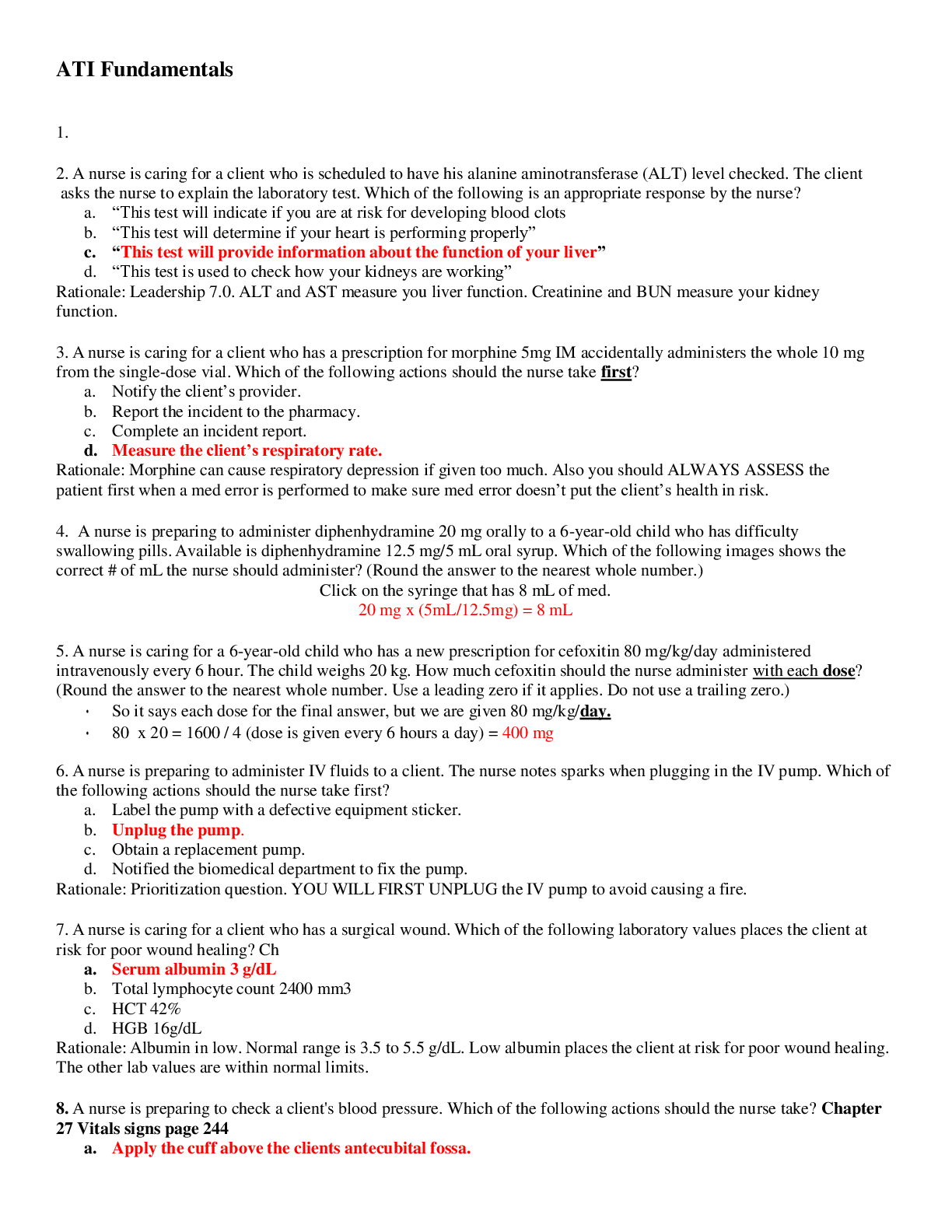
Reviews( 0 )
Document information
Connected school, study & course
About the document
Uploaded On
Apr 14, 2021
Number of pages
20
Written in
Additional information
This document has been written for:
Uploaded
Apr 14, 2021
Downloads
0
Views
107

 HESI VI EXIT EXAM.png)
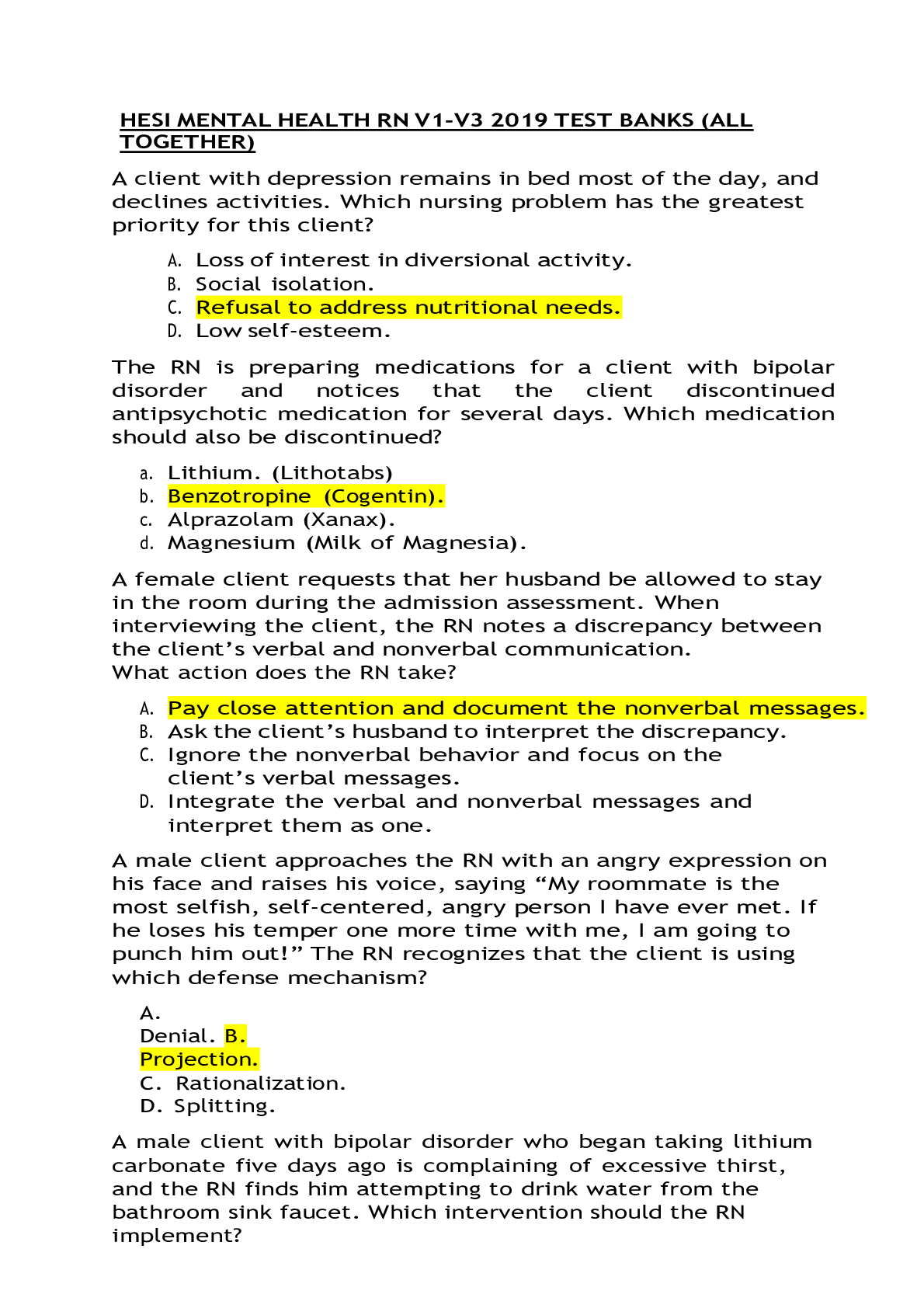

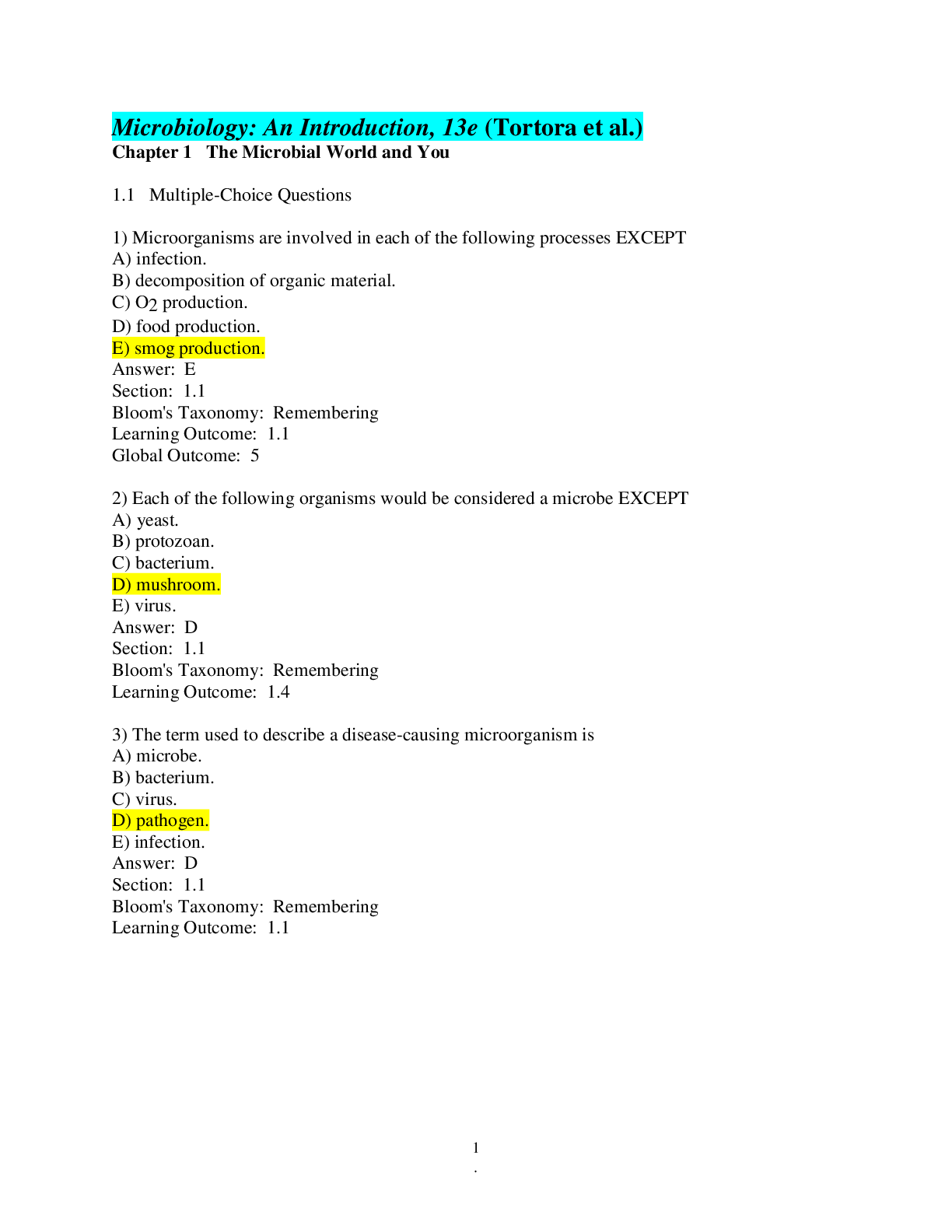

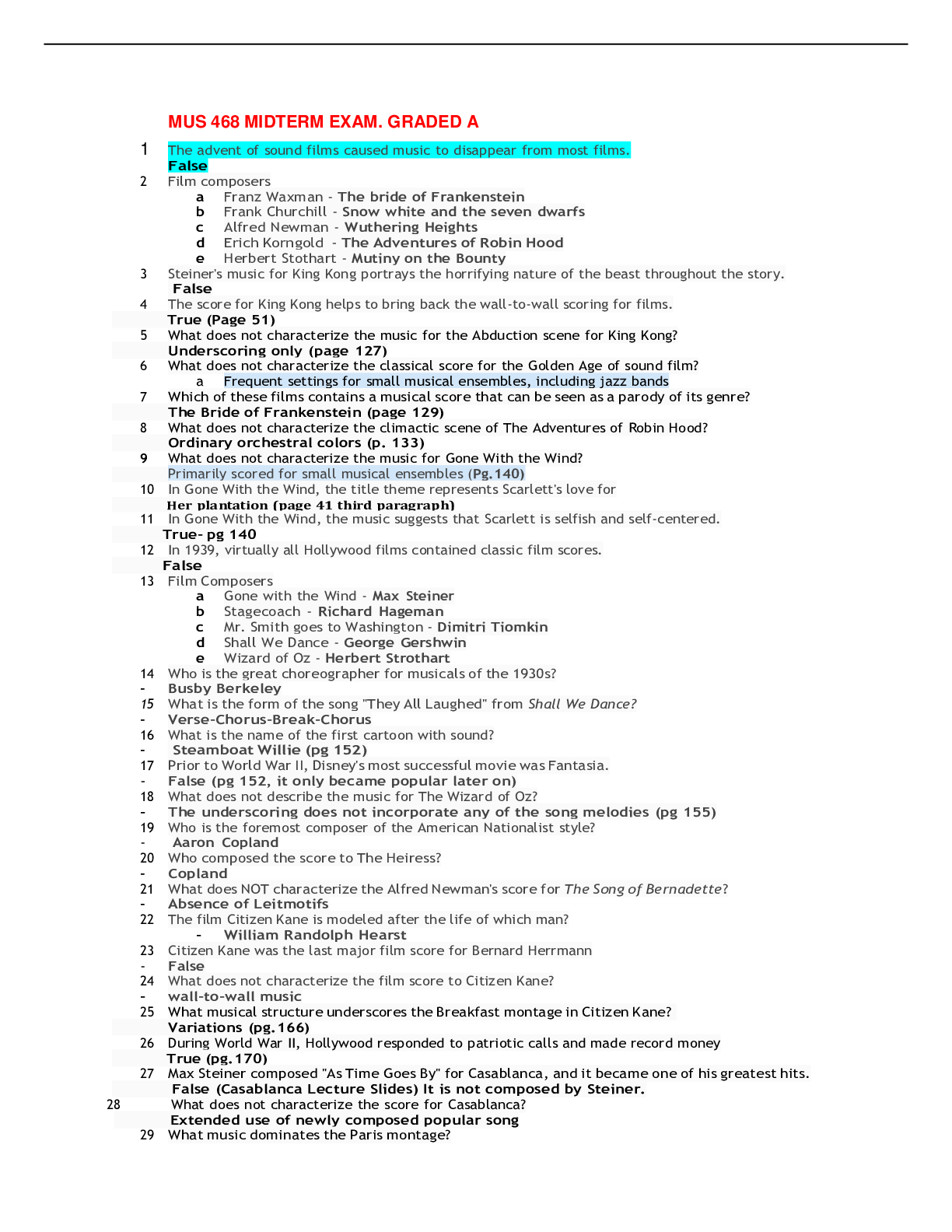
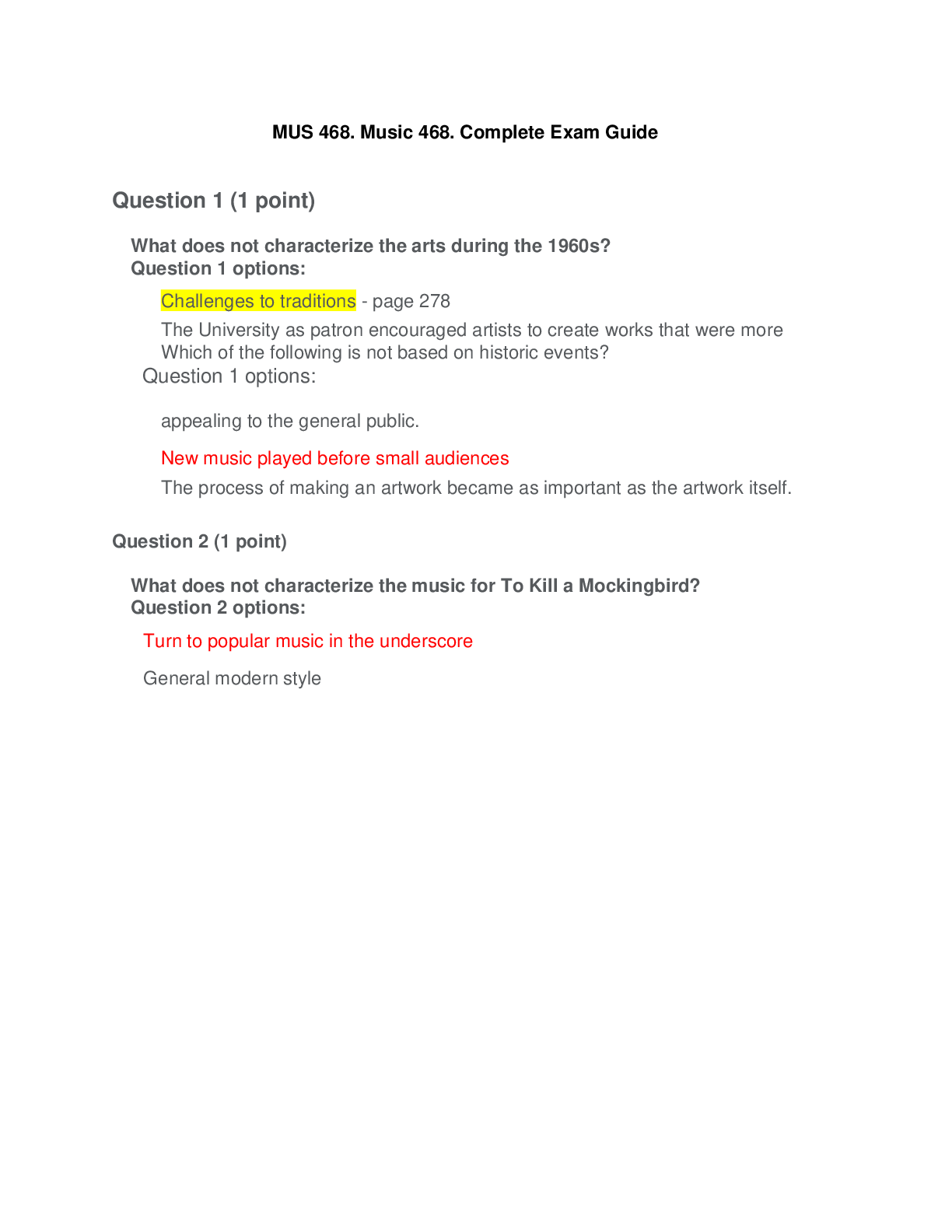
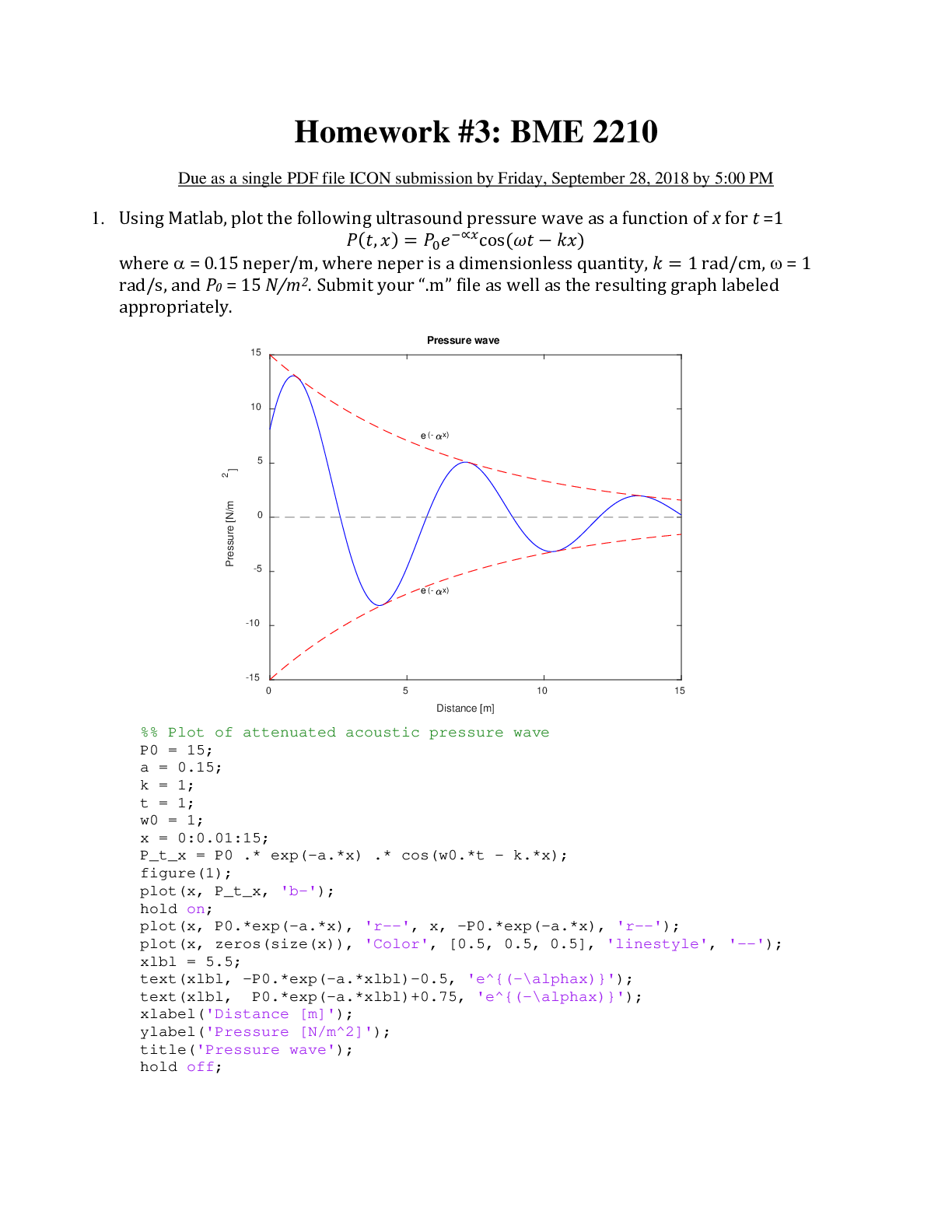


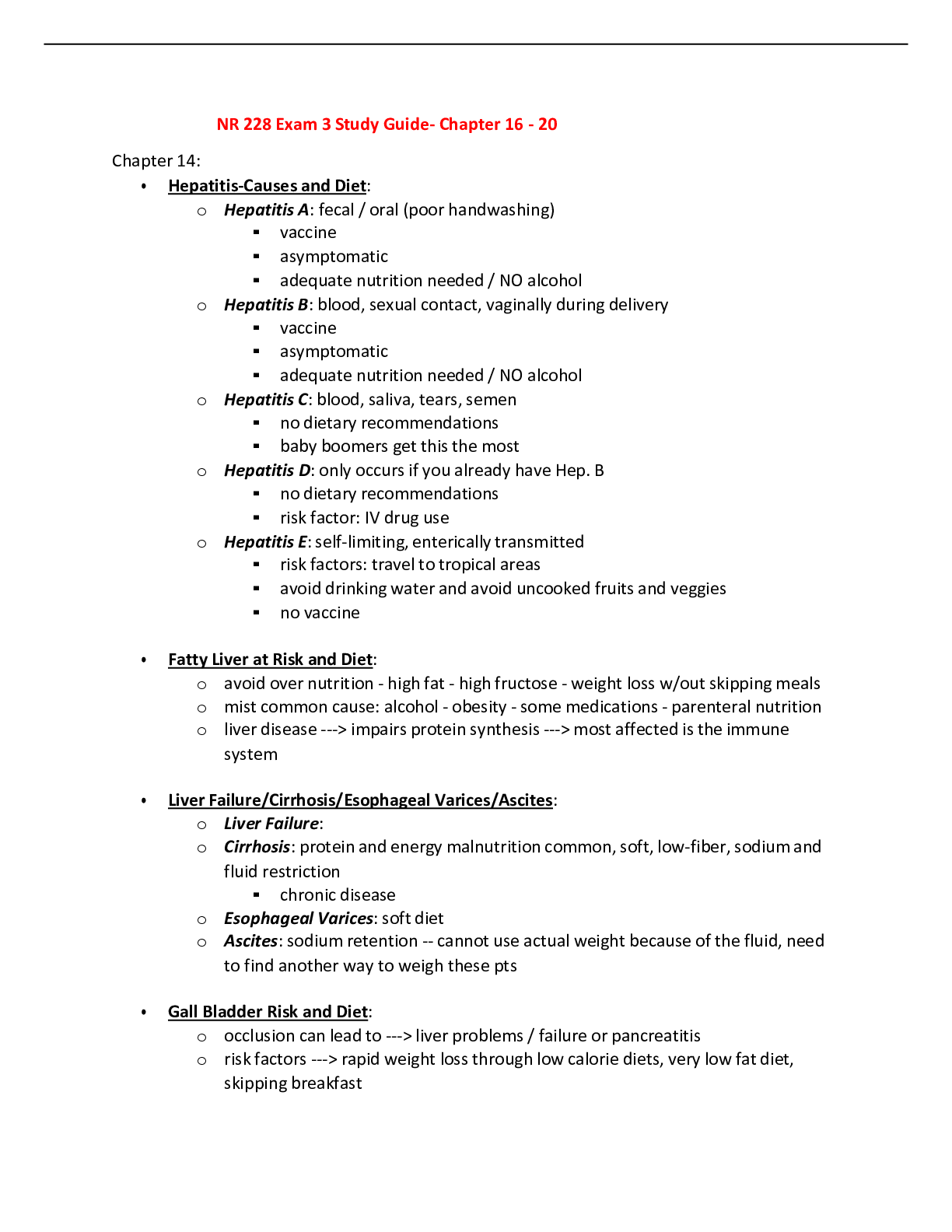
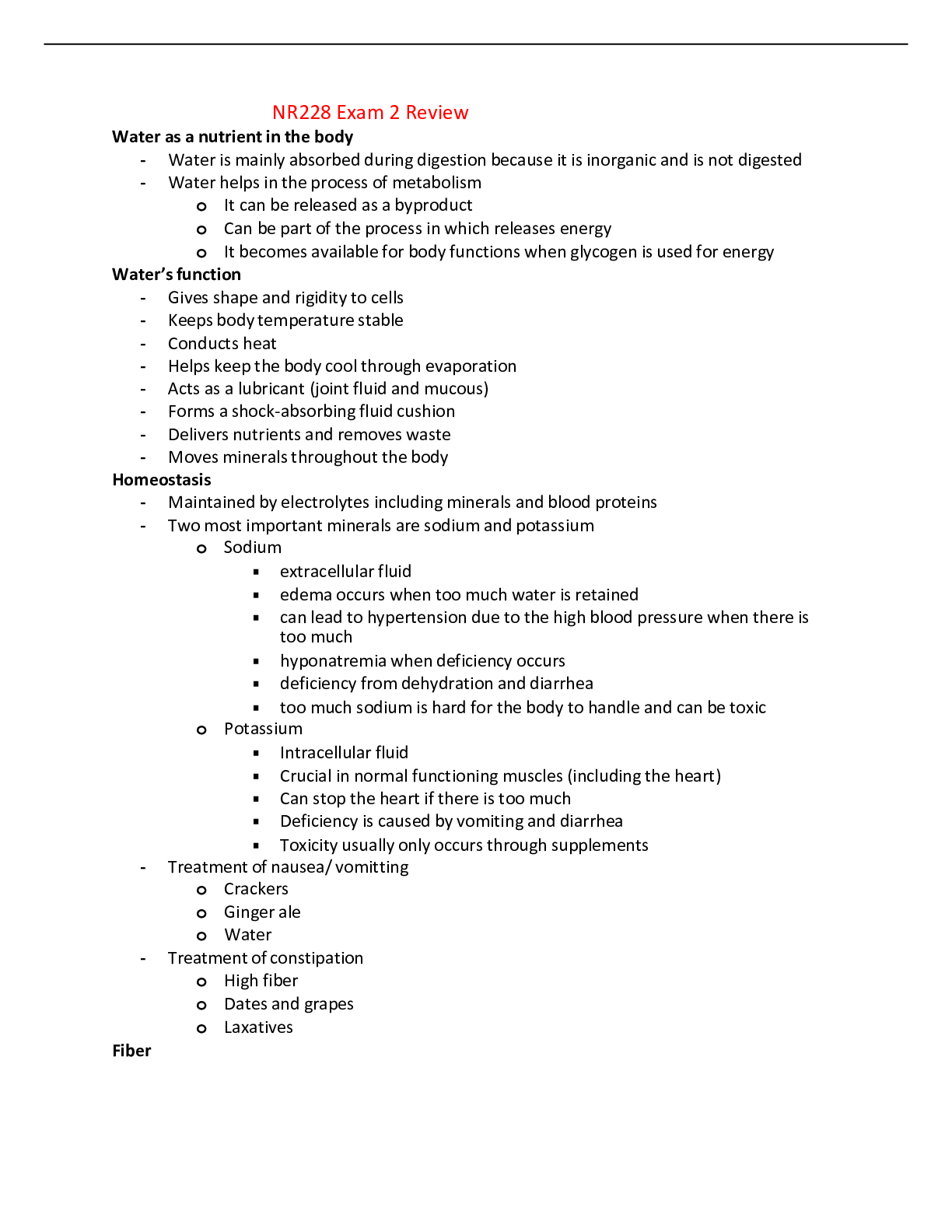




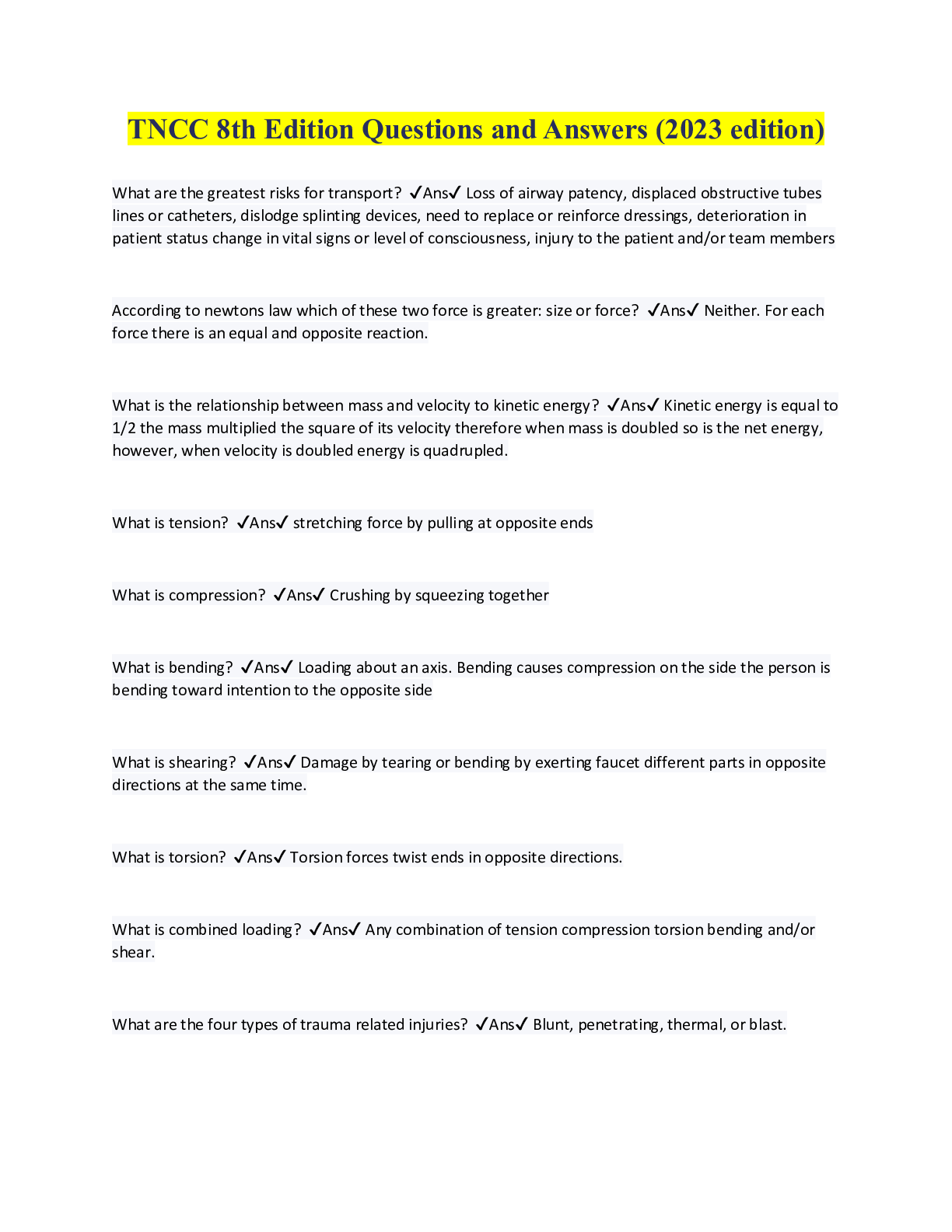
.png)

